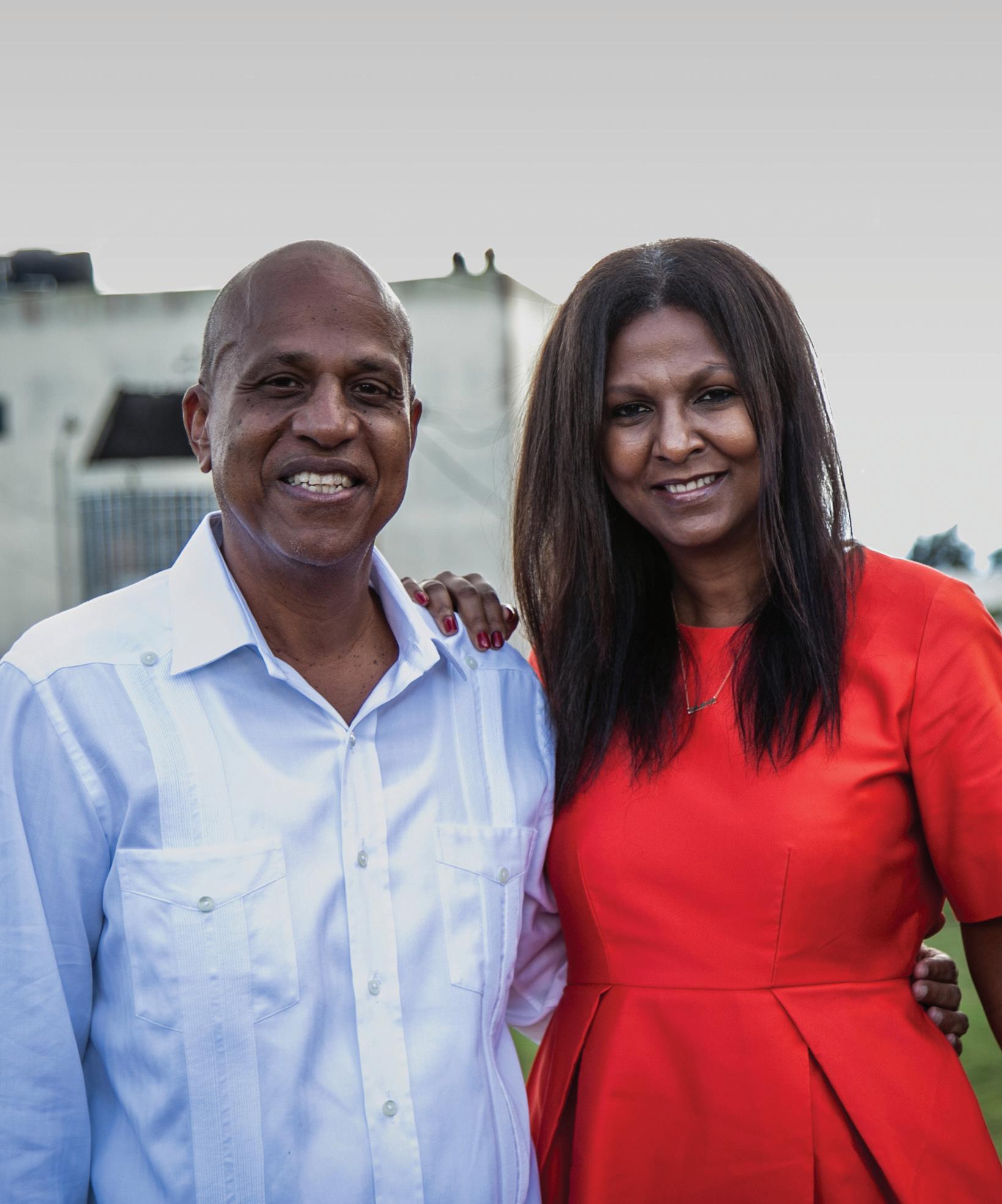 WINTER 2017 | OCEANA.ORG
WINTER 2017 | OCEANA.ORG
PLUS: FILMMAKER GAZ ALAZRAKI | SAILORS FOR THE SEA
OCEANA | WHALES OF TAÑON STRAIT
Prime Minister Dean Barrow pushes through Oceana-backed moratorium on offshore oil development
JOINS
BELIZE MAKES REEFPROTECTION HISTORY
BOARD OF DIRECTORS
Simon Sidamon-Eristoff, Chair
Valarie Van Cleave, Vice Chair
María Eugenia Girón, Treasurer
James Sandler, Secretary
Keith Addis, President
Gary Alazraki
Monique Bär
Herbert M. Bedolfe, III
Ted Danson
Sydney Davis
Cesar Gaviria
Loic Gouzer
Jena King
Stephen P. McAllister
Dr. Kristian Parker
Dr. Daniel Pauly
David Rockefeller, Jr.
Susan Rockefeller
Heather Stevens
Dr. Rashid Sumaila
Diana Thomson
Sam Waterston
Jean Weiss
EDITORIAL STAFF
Editor
Allison Guy Designer
Rosie Ettenheim
Contributing Writer
Gregg Yan
OCEAN COUNCIL

Susan Rockefeller, Chair
Julie Tauber McMahon, Vice Chair
Violaine Bernbach
Carolyn Marks Blackwood
Keely and Pierce Brosnan
Deborah Buck
Richard M. Burnes, Jr.
Amy and Gary Churgin
Vin Cipolla
Barbara Cohn
Ann Colley
Andrew Davis
Sydney Davis
Michael Dershewitz
Edward Dolman
Barbara Ettinger and Sven Huseby
Lise Evans
Christina Falco and Michael Frumkin
Kay Fernandez Joanna and Brian Fisher
Kelsey Grammer
Carolyn Groobey
Kelly T. Hallman
Marjorie Harris
Julie Hill
Carey Hotchkis
Hardy Jones
Angela and J. Stephen Kilcullen
Arlene and Robert Kogod
Slane Holland Lightburne
Ann Luskey
Willa and Ted Lutz
Dede McMahon
Tiffany Moller
Aaron Peirsol
Nicole Polizois
Perri and Mario Procida
Lori and John Reinsberg
David Rockefeller, Jr.
Anne Alexander Rowley
Eve Kornyei Ruffato
Andrew Sabin
Jennifer Small and Adam Wolfensohn
Danielle Steakley
Sutton Stracke
Mia Thompson
Dr. David Treadway
Susan Trees
Toby Usnik
Jennifer Schwab Wangers
David Max Williamson
Raoul Witteveen
OCEANA is the largest international advocacy organization focused solely on ocean conservation. We run science-based campaigns and seek to win policy victories that can restore ocean biodiversity and ensure that the oceans are abundant and can feed hundreds of millions of people. Oceana victories have already helped to create policies that could increase fish populations in its countries by as much as 40 percent and that have protected more than 1 million square miles of ocean. We have campaign offices in the countries that control close to 40 percent of the world’s wild fish catch, including in North, South and Central America, Asia and Europe. To learn more, please visit www.oceana.org.

OCEANA STAFF
Chief Executive Officer
Andrew Sharpless
President James Simon
Chief Scientist & Strategy Officer
Michael Hirshfield, Ph.D.
Chief Policy Officer, North America Jacqueline Savitz
Senior Vice President & Executive Director, Europe Lasse Gustavsson
Senior Vice President, Strategic Marketing & Communications Matthew Littlejohn
Vice President, Belize Janelle Chanona
Executive Director, Oceana Canada Joshua Laughren
Vice President, Peru Patricia Majluf, Ph.D.
Vice President, Chile Liesbeth van der Meer
Vice President, Philippines Gloria Estenzo Ramos, J.D.
Interim Vice President, Brazil Ademilson Zamboni, Ph.D.
Vice President, Development Nancy Golden
Chief Financial Officer Christopher Sharkey
Chief of Staff Leslie Jones
Deputy Vice President, U.S. Pacific Susan Murray
Oceana is published by Oceana Inc. For questions or comments about Oceana, or to subscribe to Oceana, please call our membership department at +1.202.833.3900, e-mail membership@oceana.org or write Oceana, Member Services, 1350 Connecticut Ave. NW, 5th Floor, Washington, D.C. 20036, USA.
Oceana’s Privacy Policy: Your right to privacy is important to Oceana, and we are committed to maintaining your trust. Personal information (such as name, address, phone number, e-mail) includes data that you may have provided to us when making a donation or taking action as a Wavemaker on behalf of the oceans. This personal information is stored in a secure location. For our full privacy policy, please visit Oceana.org/privacypolicy.
Please recycle.
Printed with Eco-Ink — low volatility vegetable oil-based ink on 25% post-consumer recycled, processed chlorine free paper produced using 100% wind power in a carbon neutral process.
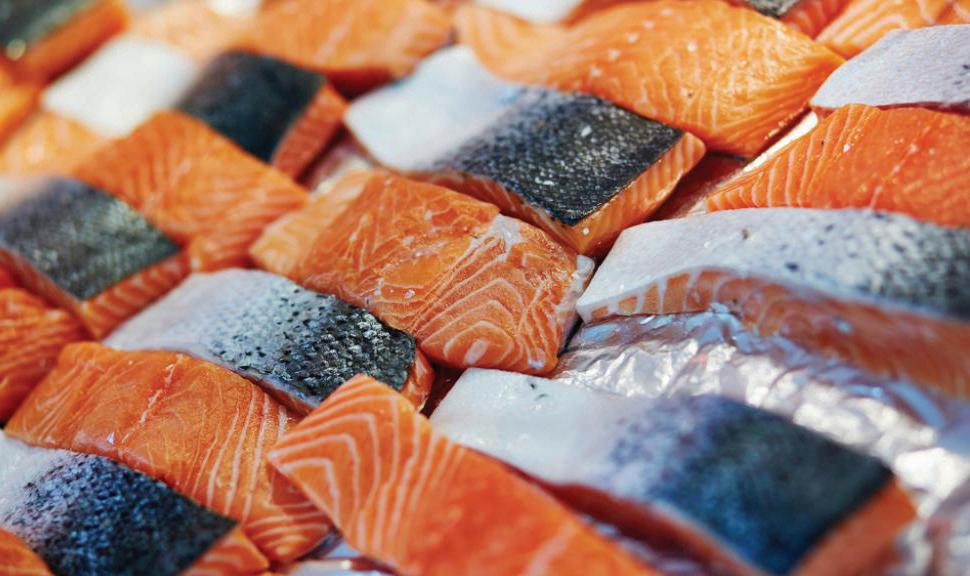



DEPARTMENTS 1 2 4 25 26 6 7 24 28 29 30 FEATURES 10 18 8 CHILE’S SALMON FARMS REPORT MORE ANTIBIOTIC USE THAN ANY OTHER MEAT INDUSTRY Sky-high antibiotic application fosters ideal conditions for drugresistant bacteria “BELIZEAN PRIDE” TRIUMPHS A seven-year Oceana campaign culminates in a historic win for the country’s barrier reef IN THE PHILIPPINES, THE QUEST TO GLIMPSE A TINY GIANT Photographer Gregg Yan searches for pygmy sperm whales in Tañon Strait CEO NOTE What the world can learn from Belize’s groundbreaking offshore oil legislation FOR THE WIN Mediterranean corals protected, Chile restricts bottom trawls and more NEWS & NOTES U.S. communities oppose offshore oil, seafood mislabeling in Canada and more Q&A Filmmaker Gary “Gaz” Alazraki VICTORY LISTORY A timeline of success FISH TALE How marine reserves can help fishermen EVENTS Introducing the SeaChange chairs ASK DR. PAULY Renowned fisheries experts Daniel Pauly and Rashid Sumaila in conversation SUPPORTER SPOTLIGHT David Rockefeller Jr. & Sailors for the Sea CHEF’S CORNER Barton Seaver’s smoked sardines with mixed greens and fig-olive dressing PARTING SHOT A fragile cod comeback in Canada’s Gulf of St. Lawrence CHEAP FISH, DEADLY INFECTIONS | 10 A MAJOR WIN FOR CORALS AND CLIMATE | 12 MEDITERRANEAN CORALS PROTECTED | 2 THE QUEST TO GLIMPSE A TINY GIANT | 20 Cover: Prime Minister Barrow with first lady and Oceana supporter Kim Simplis Barrow. ©Knight and Day Photos
PLEASE GIVE GENEROUSLY TODAY
Your contribution will help ensure our oceans are vibrant and sustainable. Help us save the oceans, feed the world.
Call us today at (202) 833-3900, email us at info@oceana.org, visit www.oceana.org/give or use the envelope provided in this magazine to make a donation. Oceana is a tax-exempt 501(c)3 organization and contributions are tax-deductible to the fullest extent of the law.

We could whaley use your support.
©Xinhua Chinese
©Eduardo Sorensen
Xiangshan
Friend of Oceana:
One of the most productive places in the world’s ocean is the East China Sea. Located just off the coast of China, each year there’s a saltwater gold rush when the fishing season opens and hundreds of big commercial fishing vessels squeeze out through the harbor in Zhejiang.

of Oceana. Prime Minister Dean Barrow of Belize had reason to breathe a big sigh of relief. After years of discussion, the Government of Belize had, just the month before, formally protected its reef from the threat of ocean oil drilling. Prime Minister Barrow had to have looked at those disastrous images from the East China Sea and imagined how cataclysmic a similar collision would be for Belize, a country whose economy depends on coastal tourism and fishing.
On Sunday January 6, the Sanchi, an Iranian oil tanker carrying one million barrels of condensate, collided with CF Crystal, a freighter. Adrift and out of control in the East China Sea, at noon that day, according to China Central Television, the Sanchi “suddenly ignited.” Then, for more than a week, the tanker burned, producing a plume of of smoke that loomed a thousand meters high, all the while releasing its volatile contents into the ocean, where it also flickered into flame. After more than a week of this maritime agony, the ship sank.
The health of the East China Sea then depended on which direction the wind and currents would take all that oil. Some analysts at the time, like Adam Minter, who wrote about the disaster for Bloomberg News, said it had the potential to be one of the worst oil spills in half a century.
It is possible that you didn’t even hear about it.
One person who I am certain did learn of it right away is on the cover of this issue
If the Americans (remember Deepwater Horizon in 2010 in the Gulf of Mexico?) and the Chinese cannot prevent or contain oil disasters in the middle of their prime fishing grounds, what would a small developing country like Belize do when the oil drillers and oil shippers blundered into the kind of trouble they never fail to deliver?
Belize is home to the second longest barrier reef in the world and 40 percent of the Mesoamerican Reef. Together with its neighbor to the north, Mexico, and its neighbor to the south, Honduras, it has custody of this irreplaceable global marine asset. Well-managed, it can sustain ocean jobs and fisheries forever. But just one oil disaster would wreck it for many lifetimes.
We celebrate the sensible decision to protect the Belizean reef. It is a beautiful and productive place that vividly shows how an abundant ocean can sustain a good life for its fishers and its coastal residents and businesses.
Many of the readers of this magazine are Americans who live by the coast. You will know that the current American administration has formally proposed opening the entire coast of the lower forty-eight states to ocean oil drilling. This proposal is an even more radical version of the previous administration’s plans to
open oil drilling off Georgia, Florida, the Carolinas and Virginia. Both proposals put valuable fisheries and extraordinary coastal beaches at peril of entirely predictable oil slicks and industrial pollution. Oceana is at the forefront of the battle against this policy. Thanks to support from many of the people reading this magazine, we now have 11 fulltime grassroots organizers helping local business leaders, conservationists and fishers to stand up and be heard. And we are being heard. As of this writing, an unprecedented 15 coastal governors from both parties have spoken out in opposition to ocean oil drilling. Key members of congress from both parties have also joined us in formal opposition.
Now we need Interior Secretary Zinke and President Trump to get our message. Maybe they should place a call to Belize. Prime Minister Dean Barrow and the people of Belize know what to tell them.





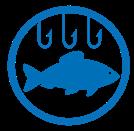
For the oceans, Andrew Sharpless CEO Oceana
To help you navigate Oceana’s work, we’re introducing icons for our five major campaigns. Look for them throughout the magazine to learn more about what Oceana focuses on.
Dear
CEO NOTE OCEANA.ORG | 1
INCREASE TRANSPARENCY CURB POLLUTION PROTECT HABITAT REDUCE BYCATCH
STOP OVERFISHING
What the world can learn from Belize’s groundbreaking offshore oil legislation
©Xinhua / Alamy Stock Photo
Chinese fishing vessels depart Xiangshan Harbor.
FOR THE WIN
Endangered Mediterranean corals win much-needed protection
How’s this for old: Some deep-sea corals found off Hawaii started growing 4,200 years ago. These species, which can grow just a few thousandths of a millimeter per year, are no match for heavy fishing gear and industrial dredges that scour the seafloor.

In the Mediterranean, for example, human activity has slashed bamboo coral by 80 percent in the last century. Cockscomb cup corals have dropped by half. But help is on the horizon for these fragile deep-dwellers.
Spurred by Oceana advocacy, last December Mediterranean countries voted to add bamboo coral and three other deep-sea corals to a list of endangered species in the region. This decision, hailed by Oceana scientist Ricardo Aguilar as a “breakthrough,” will bolster calls to expand the region’s patchy marine reserve network — protecting not only centenarian corals, but the diverse animals that live among them.

2 | SPRING 2018
Yellow tree coral is among the newly protected species.


98 percent of Chile’s waters protected from habitat-destroying bottom trawls
Fisheries scientists often say that using bottom trawls — weighted fishing nets that plow through the seafloor— is the equivalent of clear-cutting a forest to catch one deer. These nets rip up delicate sponges, corals and other habitat-forming lifeforms that can take centuries to grow. Now, 98 percent of Chile’s waters are off-limits to this destructive form of fishing gear.
Last December, Pablo Berazaluce, the Undersecretary for Fisheries and Aquaculture, and Liesbeth van der Meer, the executive director of Oceana’s Chile office, announced that the country would “freeze the footprint” of the existing bottom trawling fleet to the region where it’s operated for the last 16 years.
Van der Meer noted that the decision was made in partnership with artisanal and commercial fishing representatives, demonstrating the value of open dialogue. “Banning the expansion of bottom trawling is a major step in protecting the oceans,” she added.
Court rejects irresponsible anchovy fishing quota in California
Anchovies are a cornerstone of California’s marine ecosystem, feeding animals from sea lions to swordfish. These little fish often occur in staggering abundance, but their numbers can plummet in response to man-made and natural conditions. Oceana scientists have long argued that it’s dangerous to fish anchovies when they’re already struggling — and in January, a judge agreed.
In response to an Oceana lawsuit, as represented by Earthjustice, a federal judge struck down a National Marine Fisheries Service decision that set a 25,000-metric-ton catch limit for anchovies in central California. The court found that when setting the catch amount, the Fisheries Service had used decades-old numbers that vastly overestimated anchovy populations, rather than relying on recent data that showed the fish had slipped to historic lows.
“This decision holds the Fisheries Service to fundamental standards intended by Congress,” said Mariel Combs, Oceana’s pacific counsel. “These standards require the government to use the best available science to sustainably manage our nation’s fisheries for the benefit of both fishermen and dependent species.”
Canada makes the health of its fisheries more transparent to citizens
How sustainable is Atlantic cod? Are Canada’s redfish on the mend? With government fisheries data scattered across dozens of sources, answering these questions once required detective skills worthy of Sherlock Holmes.
Seafood sleuths can now pack away their deerstalker caps. Fulfilling a commitment from Oceana Canada’s 2016 science symposium, the Government of Canada has added 170 commercially and culturally important fish stocks to the online Sustainability Survey for Fisheries, which it will be updating annually.

“Canadians now have a clearer picture of how our fish populations are doing,” said Josh Laughren, the executive director of Oceana Canada. According to the survey, fewer than half of the country’s fish populations are considered healthy, and a further 25 percent can’t be assessed at all due to lack of data. “The new Sustainability Survey for Fisheries is an important step toward helping restore abundance to Canada’s oceans,” Laughren added.
Find out more about the state of Canada’s fisheries at FisheryAudit.ca.

FOR THE WIN OCEANA.ORG | 3
Massive opposition greets the Trump administration’s radical offshore drilling plan
In early January, the Trump administration announced a proposal to open nearly all U.S. waters to offshore drilling, including the Atlantic, Pacific and Arctic, as well as areas under moratorium in the eastern Gulf of Mexico. The administration has said this is the largest proposed lease sale ever offered by any president.
Opposition from coastal businesses, fishing groups and elected officials has been fierce. Just days after the original announcement, Secretary of the Interior Ryan Zinke announced Florida would be removed from the proposal.
“While it’s unclear whether this announcement is an official policy statement, the secretary has said local voices matter,” said Diane Hoskins, Oceana’s campaign director. “And that’s precisely what Oceana has set out to do: ensure local communities who have the most to lose understand what’s been proposed, what’s at stake, and make their voices heard.”
Since 2013, Oceana has been the leader in organizing grassroots opposition to offshore oil expansion. As of February, more than 180 East and West Coast municipalities have expressed their opposition to or concern over offshore drilling activities, along with more than 1,200 elected officials, regional fishery councils, the Department of Defense, and an alliance representing over 42,000 businesses and 500,000 fishing families. Oceana is organizing events nationwide to demonstrate the bipartisan, diverse, and strong opposition to offshore drilling.


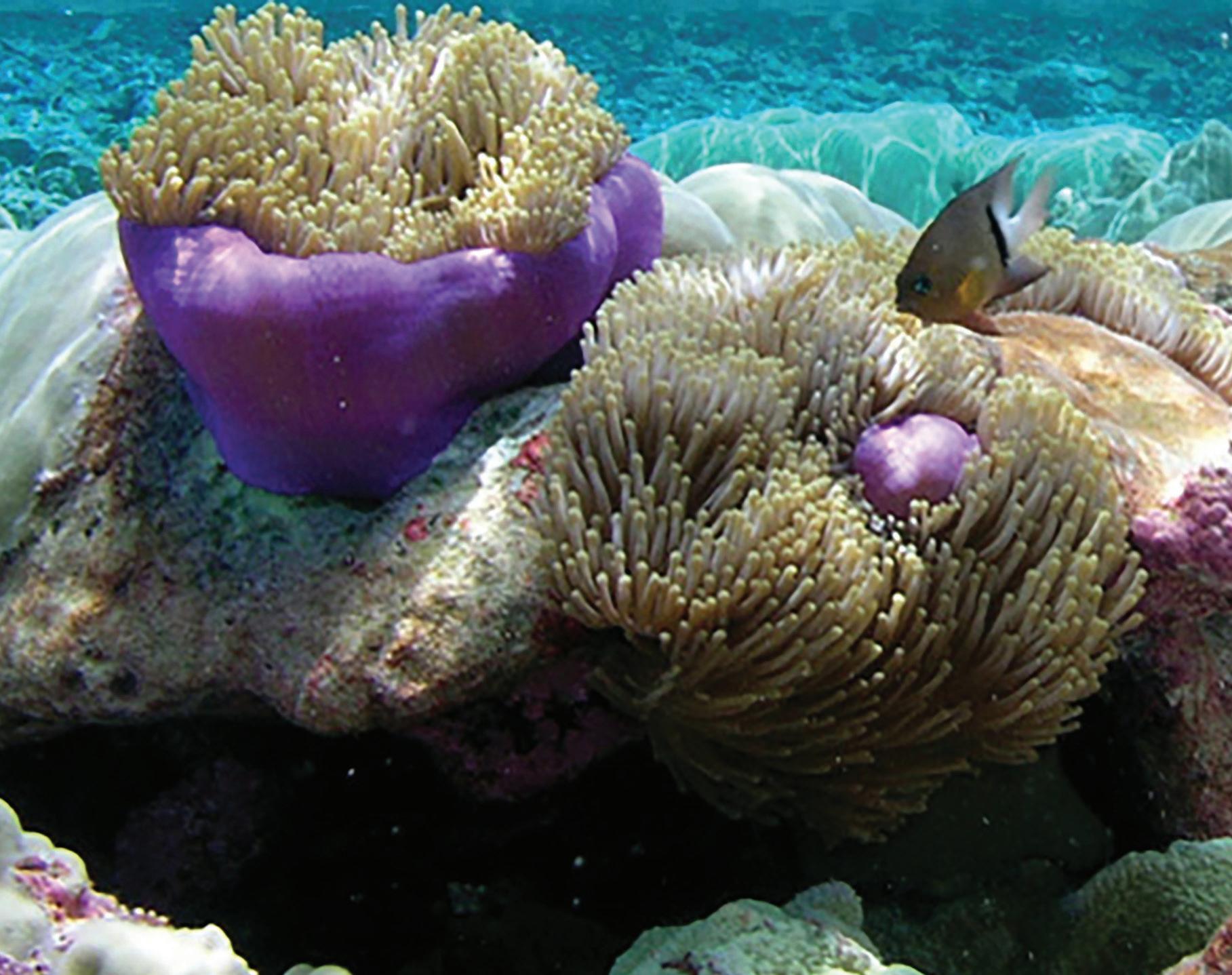

Interior Secretary to whittle away vibrant marine
U.S.
monuments
The Trump administration recently slashed Utah’s Bears Ears and Grand StaircaseEscalante National Monuments by 85 percent — but these aren’t the only national monuments that have landed on the cutting board. In December, Secretary of the Interior Ryan Zinke recommended that the management of three vast marine monuments be returned to regional fishery councils, opening the door to commercial fishing in these pristine areas.
One, the Pacific Remote Islands national monument, is a bipartisan success, created by George W. Bush in 2009 and later expanded by Barack Obama. Another, the Northeast Canyons and Seamounts in New England, hosts critically endangered right whales and submarine seamounts carpeted in deep-sea corals. And Rose Atoll Marine National Monument, in the South Pacific, encompasses 13,451 square miles of small islands and rich coral reefs.
4 | SPRING 2018
©Oceana/Keith
NEWS & NOTES
Anemones in the Pacific Remote Islands Marine National Monument.
©USFWS
Tuna illegal
©Oceana/Patrick Mustain
Virginians protest offshore oil.
Tuna are at high risk of illegal fishing.
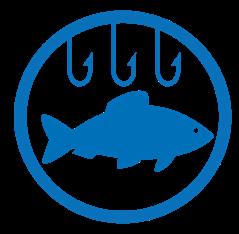



Half of seafood samples tested in Canada are mislabeled

If you eat seafood in Ottawa, there’s a good chance you’re not getting what you ordered. Almost half of the 98 samples Oceana tested in Canada’s capital city were mislabeled. The problem was particularly pronounced in sushi restaurants: Almost 70 percent of sushi samples were masquerading as something else.
“Canada lags behind the U.S. and the EU when it comes to boat-to-plate seafood traceability,” said Josh Laughren, executive director of Oceana Canada. “We’re calling on the Canadian Food Inspection Agency to make combating seafood fraud a priority and to ensure all seafood sold in Canada is safe, legally caught and honestly labeled.”


New England protects 25,000 square miles of deep-sea corals

An area roughly the size of Vermont, New Hampshire, Connecticut and Rhode Island combined is now set to be off-limits to destructive bottom trawling in the Gulf of Maine and Georges Bank. The New England Fishery Management Council approved these new protections in January as part of a conservation plan for fragile deep-sea corals, which act as nurseries for fish and other marine animals. Implementation of these protections is expected later in 2018.
The EU implemented an ambitious law to combat illegal fishing. Is it working?
A decade ago, an estimated 500,000 metric tons of illegally caught seafood entered European Union markets every year. In response, the EU implemented a 2008 regulation that doles out “yellow cards” to exporter countries that don’t take appropriate action against illegal fishing, and bans imports if the country fails to follow through.
A recent report from Oceana, EJF, Pew and WWF is the first detailed analysis to discover a shift in seafood trade flows after the 2008 regulation. Worryingly, the report found that exporters of seafoods at high risk of illegality, such as tuna and swordfish, may be exploiting EU borders that are seen as more porous. This highlights the urgent need for coordinated import controls among EU members.
OCEANA.ORG | 5
©Oceana/Keith Ellenbogen
NEWS & NOTES
to bottom
Off limits
trawling Northeast Canyons and Seamounts Marine National Monument
Q&A: FILMMAKER GAZ ALAZRAKI’S

NEXT BIG PROJECT? PROTECTING MEXICO’S OCEANS
Gary “Gaz” Alazraki has made headlines in his native Mexico as the director of the 2013 hit “Nosotros Los Nobles (The Noble Family),” which doubled the previous box office record for a Mexican film. He went on to co-create and direct Netflix’s first Spanish-language original series, “Club de Cuervos (Club of Crows),” now in its third season.
While Alazraki has been transforming Latin American TV, he’s also been revolutionizing something else: how Mexico protects its oceans. Alazraki, now a member of the Oceana board, has long been a driving force behind Oceana’s Mexico office, which opened in February. We spoke with Alazraki about what interested him in marine conservation and his vision for the future of the sea.
Everyone has a connection to the ocean, be it a love of seafood or scuba diving. What’s yours?
My grandfather loves to fish. He has a house in Acapulco where I would spend Christmas with my cousins every year. There was always a day where he would take us out fishing, and we would prepare ceviche right there on the boat. As I grew older it became harder to get the fish, and I started to get a hollow feeling in my stomach that something was wrong. And that left an impression.
How did you get involved with Oceana?
It was by accident. In 2013, a friend invited me to an Oceana gala in Los Angeles. I didn’t even know what I was going to. But when Hillary Clinton introduced [Oceana CEO] Andy, I was impressed by the reach of the NGO.
Then Andy played the video of what Oceana had achieved. And at first, I wanted to die when I saw how we’ve been destroying the ocean. But as soon as Andy demonstrated that there was a very clear strategy to reverse the damage, I felt like there was an entrepreneurial mind strategically taking this complex subject and breaking it down into very manageable paths.
Andy highlighted the countries where Oceana had succeeded, and he skipped from the U.S. to South America without going through Mexico. So, I walked up to him at the end and said, what happened in Mexico? He explained that Oceana had wanted to launch in Mexico, but needed the right connections. In that minute, I committed myself. I said, I’m your man.
When you think about the future of Mexico’s oceans, what changes do you want to see?
I want to see a government and tourist initiatives that take care of the oceans. I want to see people aware of the importance of caring for the ocean, which right now, because of the poverty level, they don’t. And I also want to see stronger policies that protect the ocean from foreign fisheries that grab the fish and take it back to Asia or Europe.
Your involvement with Oceana is part of a larger pattern of support for social causes. Has philanthropy always been a part of your life?
Not really — it wasn’t until that I felt like people were listening to me that I realized I had the opportunity to make a difference. From there, people started to approach me because they wanted my help making an issue be heard, and I felt strongly about a lot of those issues. I feel it’s a responsibility as a citizen to be an active part of the conversation. If you have a voice, then use it.
Do you extend this sense of civic responsibility to your work in film and TV?
That’s what I want to do. It was famously said that artists use lies to tell the truth. If you’re not doing that, then you’re just distracting people.
You’re a father of two. Have your kids changed the way you think about environmental protection?
In a way, I’m doing this for them. I’ve become very vocal about my sense of responsibility and reciprocity for the people that came before us and will come after us. It’s neglectful to forget that we are just a link in a long evolutionary chain that needs us to preserve it.
6 | SPRING 2018 ©Stuart
Q&A
A TIMELINE OF SUCCESS
FEBRUARY
Chile announces protected area in Tortel to preserve pristine habitat JANUARY 21 countries and the EU protect endangered cold-water corals throughout the Mediterranean Chile protects Juan Fernandez Islands and wildlife found nowhere else on earth Belize bans offshore oil drilling, protecting the largest barrier reef in the Americas
DECEMBER
Canada acts to make the status of fisheries more transparent to its citizens Chile protects ocean habitat and wildlife, bans bottom trawling in 98 percent of its seas
NOVEMBER
The Philippines appoints a special prosecutor to prosecute illegal commercial fishing in one of the country’s largest marine protected areas
SEPTEMBER
Peru agrees to publish vessel tracking data through global fishing watch to help fight illegal fishing European parliament acts to end overfishing in the North Sea AUGUST
U.S. court upholds rule requiring traceability for at-risk seafood imports Chile rejects major industrial port and mining project that threatened penguins, whales and fragile habitat
JULY Chilean Supreme Court forces salmon farming industry to disclose antibiotic use
JUNE
Legal reform makes EU’s external fishing fleet more transparent, accountable and sustainable
APRIL
U.S. takes action to protect West Coast sardines from overfishing for the third consecutive year
Hundreds of critical forage species safeguarded off the entire U.S. West Coast New pact commits nations to rebuilding a healthy Mediterranean Sea
To see more victories, visit www.oceana.org/victories
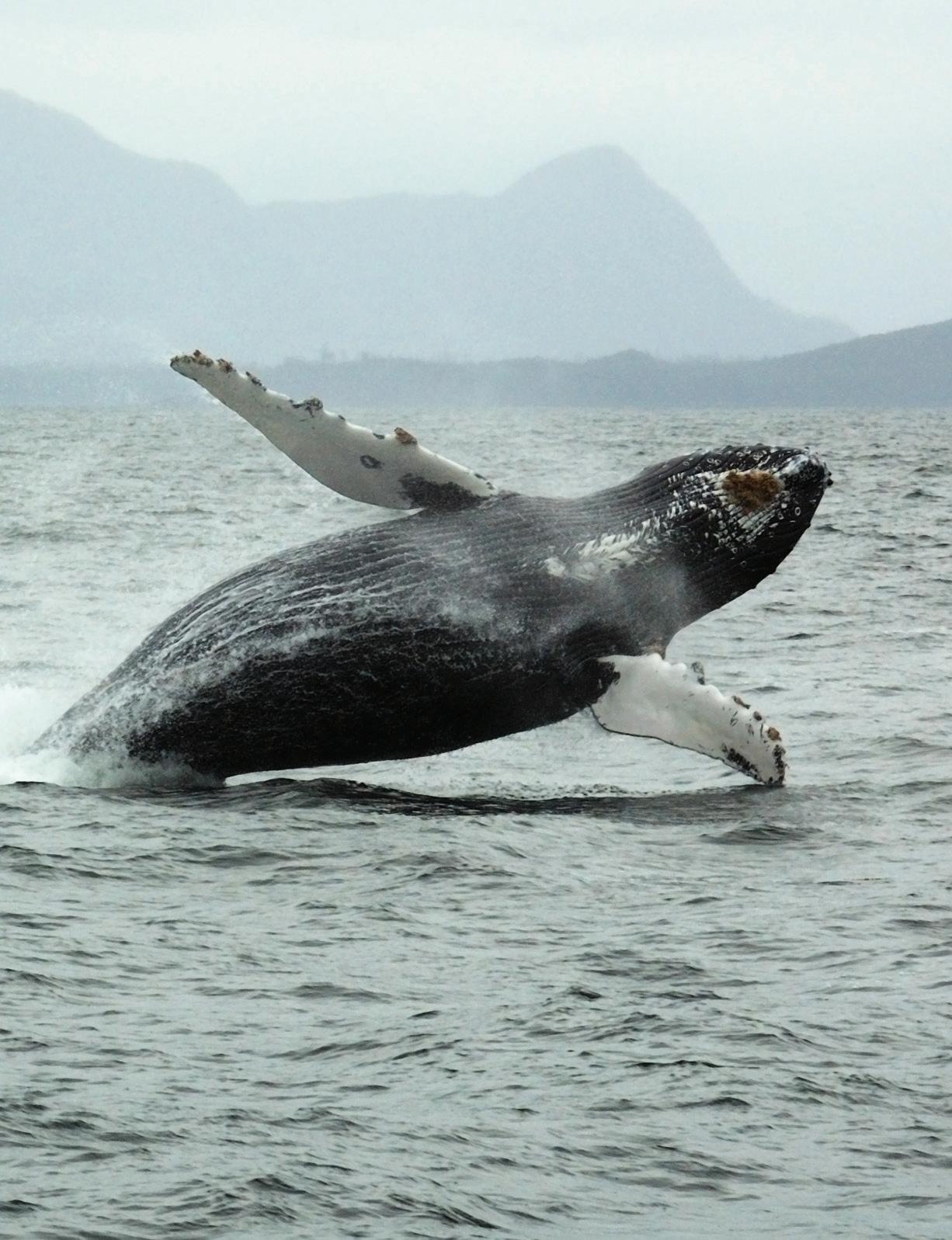
VICTORY LISTORY
OCEANA.ORG | 7 ©Stuart Slavicky
2017 2018
Chile’s salmon farms may use more antibiotics than any other meat industry.

THAT’S A BIG PROBLEM.
by Allison Guy
FEATURES 8 | SPRING 2018
If you wanted to search for the next drugresistant superbug, you could cart your microscope to a poorly regulated pig farm, or look under the glare of a hospital’s lights. But you might be better off searching somewhere more picturesque — like the chilly bays of southern Chile.
There, salmon farmers are using up to 950 grams of antibiotics to raise one ton of fish, according to a recent Oceana report. The report, the first to disaggregate antibiotic use on a company-by-company basis, shows that Chile’s salmon farmers might be applying more drugs per ton of meat than any other fish or livestock industry in the world.
Norway, which beats out Chile as the world’s number-one salmon grower, uses just 0.17 grams per ton of fish. And pork, a notoriously drug-dependent industry, uses an average of 172 grams per ton globally.
It’s a deadly calculus: The more antibiotics you use, the more antibiotic-resistant bacteria you’re likely to create. As dangerous, drug-resistant infections crop around the world, experts say that Chile could be fueling an epidemic for the sake of cheap fish.
Disaster brewing Chile’s salmon pens may look benign from the surface: a dozen or so rings or rows of netting, buoys and walkways floating just offshore. Below, it’s a different story. Densely packed fish swim in a snowstorm of antibiotics, uneaten feed, feces and delousing chemicals. It’s a perfect recipe for brewing up drug-resistant bacteria.
Conditions on these farms favor genetic mutations that protect bacteria from the effects of antibiotics. Bacteria that win the mutation lottery can then divide and spread unchecked, in a microscopic version of survival of the fittest.
These “winners” can even trade drugresistant snippets of DNA with unrelated species, a process called horizontal gene transfer. This means that bacteria that cause diseases in fish, or just live harmlessly in the water and mud around salmon farms, can pass resistance genes directly to bacteria that make humans sick.
“Consumers should be worried that we are creating super-bacteria here in Chile,” said Liesbeth van der Meer, a veterinary scientist and the head of Oceana in Chile. “And these super-bacteria are going to get to them, eventually.”
Nasty hitchhikers
Consumers are unlikely to pick up drug residues from the farmed salmon they buy in stores, van der Meer said. A quarantine period weans salmon off antibiotics before they’re killed and processed. The concern for consumers, she said, is not direct exposure to drugs, but drug-resistant bacteria and genes that spread beyond the confines of salmon pens.
There are two main ways this could happen. The first is person-to-person transfer. Bacteria can hopscotch into the wider world if an infected resident or aquaculture worker visits a hospital or a large city like Santiago, or travels to another country.
The second way drug resistance can pass to consumers is through direct contact with contaminated salmon. If someone in another country handles or eats a fillet that harbors drug-resistant bacteria, they might end up ingesting those bacteria, explained Felipe Cabello, an expert on antimicrobial resistance in marine environments at New York Medical College. Once inside the human intestinal tract, he said, the hitchhikers can swap their genes with bacteria that cause illness.
It’s enough to give sushi-lovers pause.
Safety first
So why is Chile using so many antibiotics in the first place? It’s because the country’s salmon are under assault from a hemorrhagic bacterial disease known as piscirickettsiosis. The main weapon against this epidemic is
florfenicol, a common veterinary antibiotic used to treat animals as diverse as fish, chicken and cattle, van der Meer said. Several studies suggest that florfenicolresistant bugs are widespread in and near Chile’s salmon farms.
Florfenicol resistance might not sound scary — after all, humans usually don’t take veterinary drugs. But DNA sequences that protect against one type of antibiotic can be interlinked with genes that protect against other drugs. Florfenicol-resistant bacteria, for example, can withstand a range of antimicrobials used in human medicine, including an antibiotic that’s a last-resort treatment for multidrug-resistant infections.
This problem has not gone unnoticed. A retailer backlash against drug-drenched salmon has gained momentum in recent years. In the United States, Whole Foods only stocks farmed salmon from European countries, and Target hasn’t sold farmed salmon of any kind since 2010. Other retailers, like Costco, have reduced but not eliminated sales of Chilean salmon.
However, with so many cheap Chilean fillets on the market, they can be hard to avoid. Vague U.S. regulations mean that it can be almost impossible for a consumer to know where their salmon comes from, according to Oceana seafood fraud expert Kimberly Warner.

Restaurants and small grocers aren’t required to label their fish’s country of origin, Warner said. And if a fillet is cooked, sauced or otherwise “transformed,” all bets are off: “They don’t have to tell you where it’s from, its species, or whether it’s farmed or wild.”
Consumers are the key to change, van der Meer argued, adding that pressure from advocacy groups like Oceana can only go so far. “The consumer is the one that has to be informed, that has to demand a clean and transparent industry in Chile,” she said. “We have a lot of healthy fish that you can eat. You can eat sardines. You can eat Chilean hake. Why are you choosing this highly polluting species?”
FEATURES OCEANA.ORG | 9
“Consumers should be worried that we are creating superbacteria here in Chile.”
- Liesbeth van der Meer, veterinary scientist
“BELIZEAN PRIDE” TRIUMPHS:
A seven-year Oceana-led campaign built a groundswell of public support to keep Belize’s waters oil-free. Last December, those efforts paid off.
Written by Allison Guy | Photographs by Alex Ellis, Oceana Belize
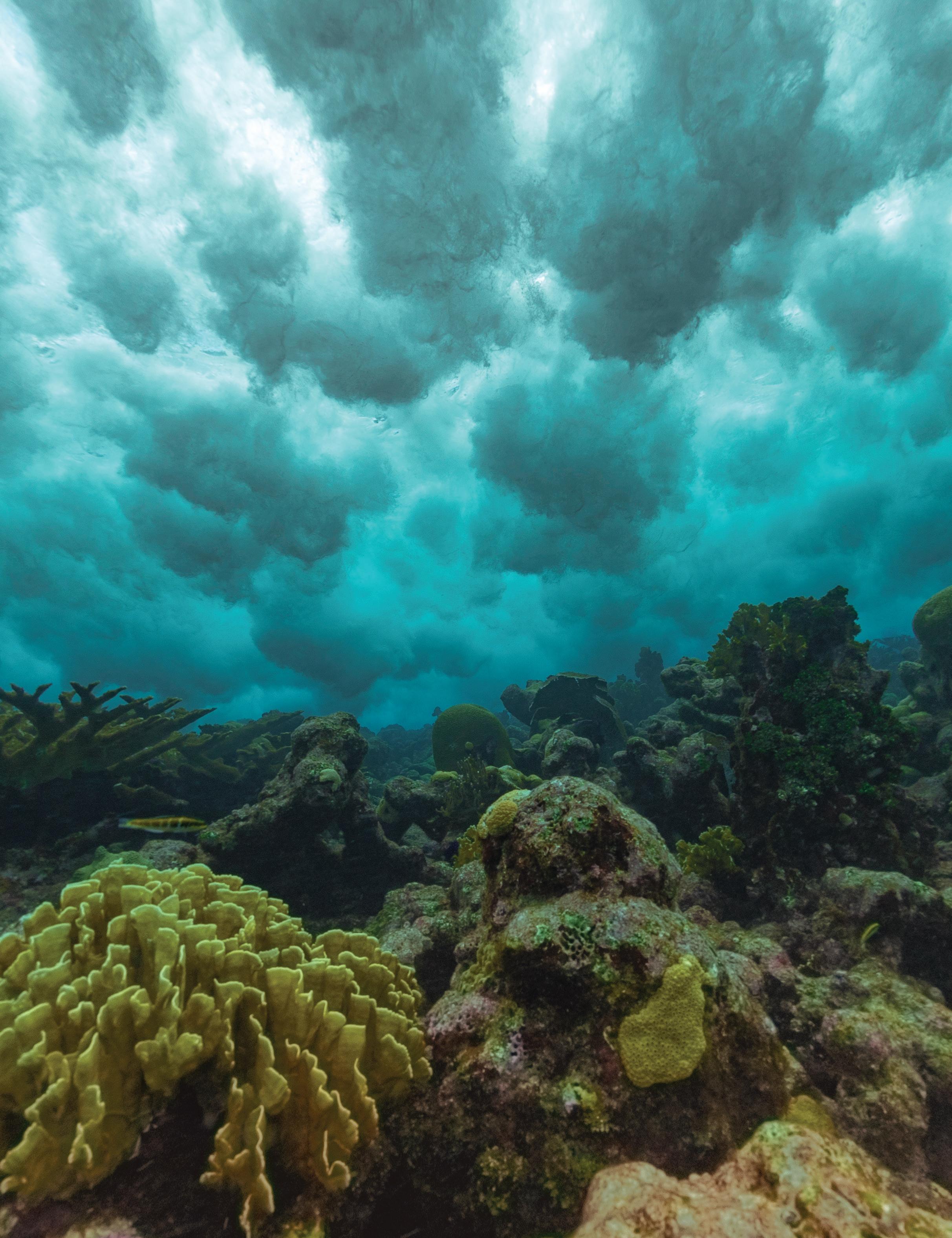
10 | SPRING 2018 FEATURES
A HISTORICAL WIN FOR THE NATION’S REEF PROTECTS CORALS, THE CLIMATE AND THE ECONOMY
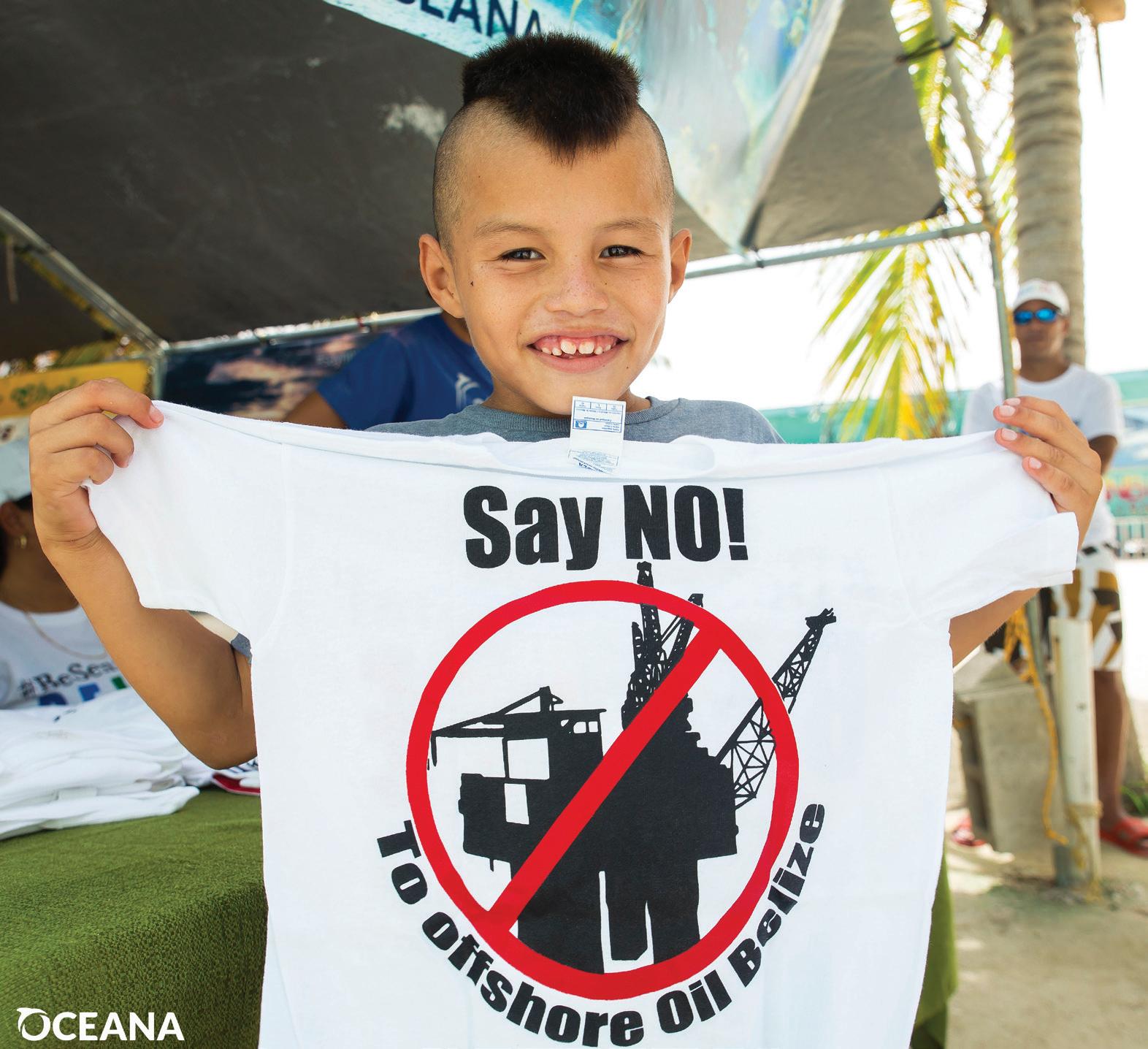
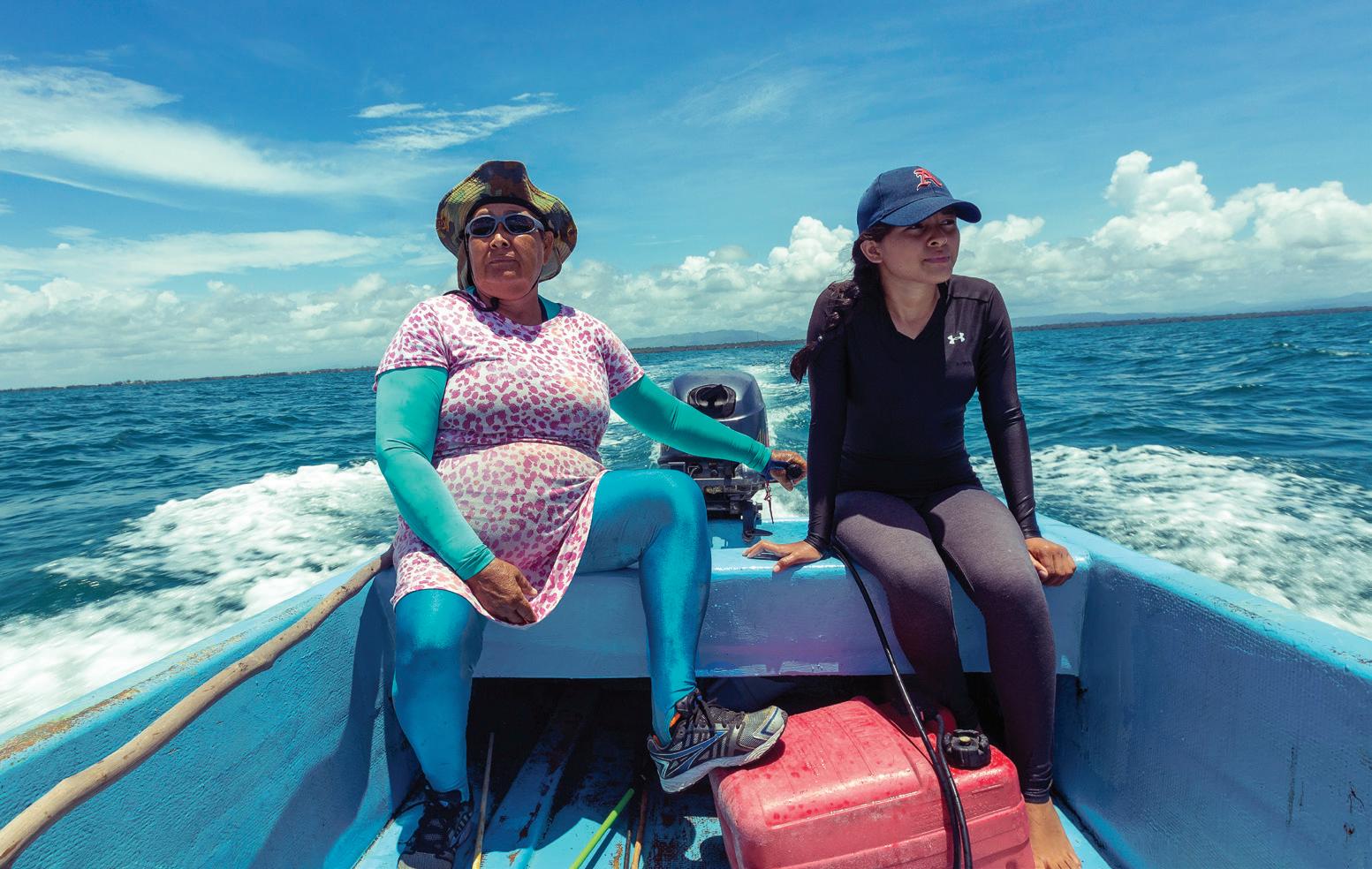
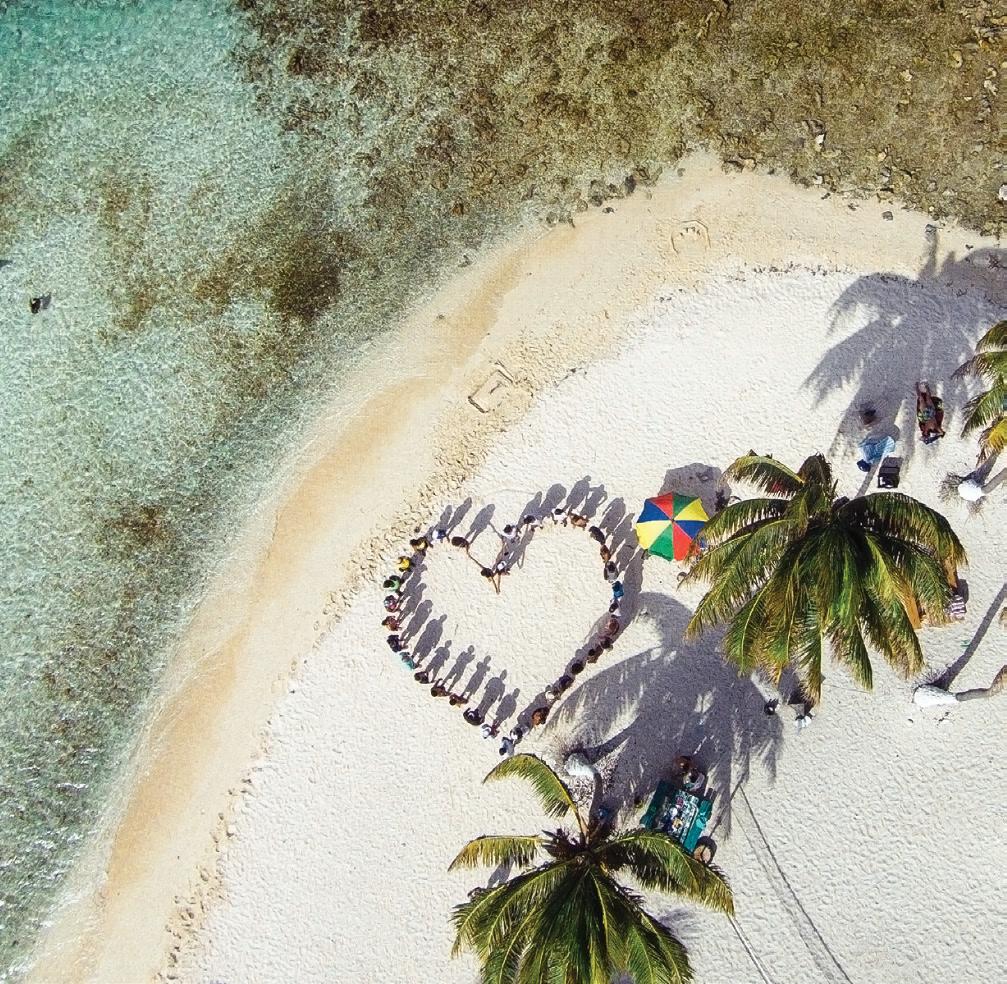


FEATURES
It sounded like rolling thunder.
At first, Jamani Balderamos wasn’t worried. Sudden, shortlived storms are common off Belize’s Turneffe Atoll, where Balderamos was leading tourists on a scuba dive. But a second rumble of thunder followed, then another and another, each spaced 10 seconds apart.

Balderamos realized it wasn’t thunder, but the tell-tale detonations of seismic airguns. Ships tow these industrial devices as part of the process for finding offshore oil deposits.
“I noticed the fish became kind of scared. They started darting all over the place,” Balderamos said. The blasts got louder. He signaled for his group to get out of the water, unsure if the airguns were dangerous. “You could actually feel the reverberation going through your body. I could feel it in my chest.”
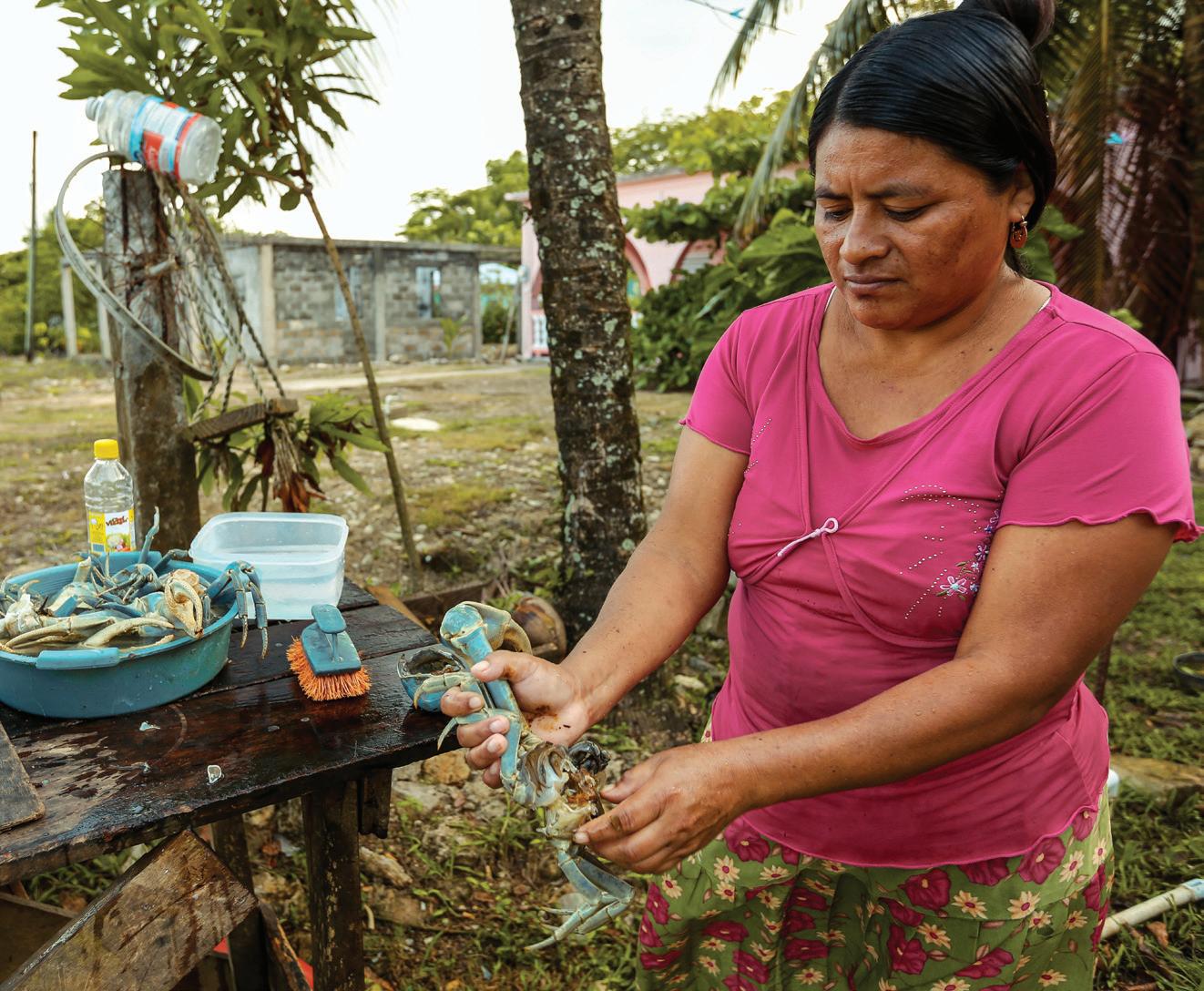
Days earlier, on October 12, 2016, Oceana had been tipped off that a seismic ship was bound for Belize. After the organization shared this news with the public, longsimmering opposition to offshore oil boiled over into outrage, said Janelle Chanona, the head of Oceana in Belize. The country’s tourism economy relies on a thriving ocean — free of airgun blasts, oil rigs and beach-coating spills.
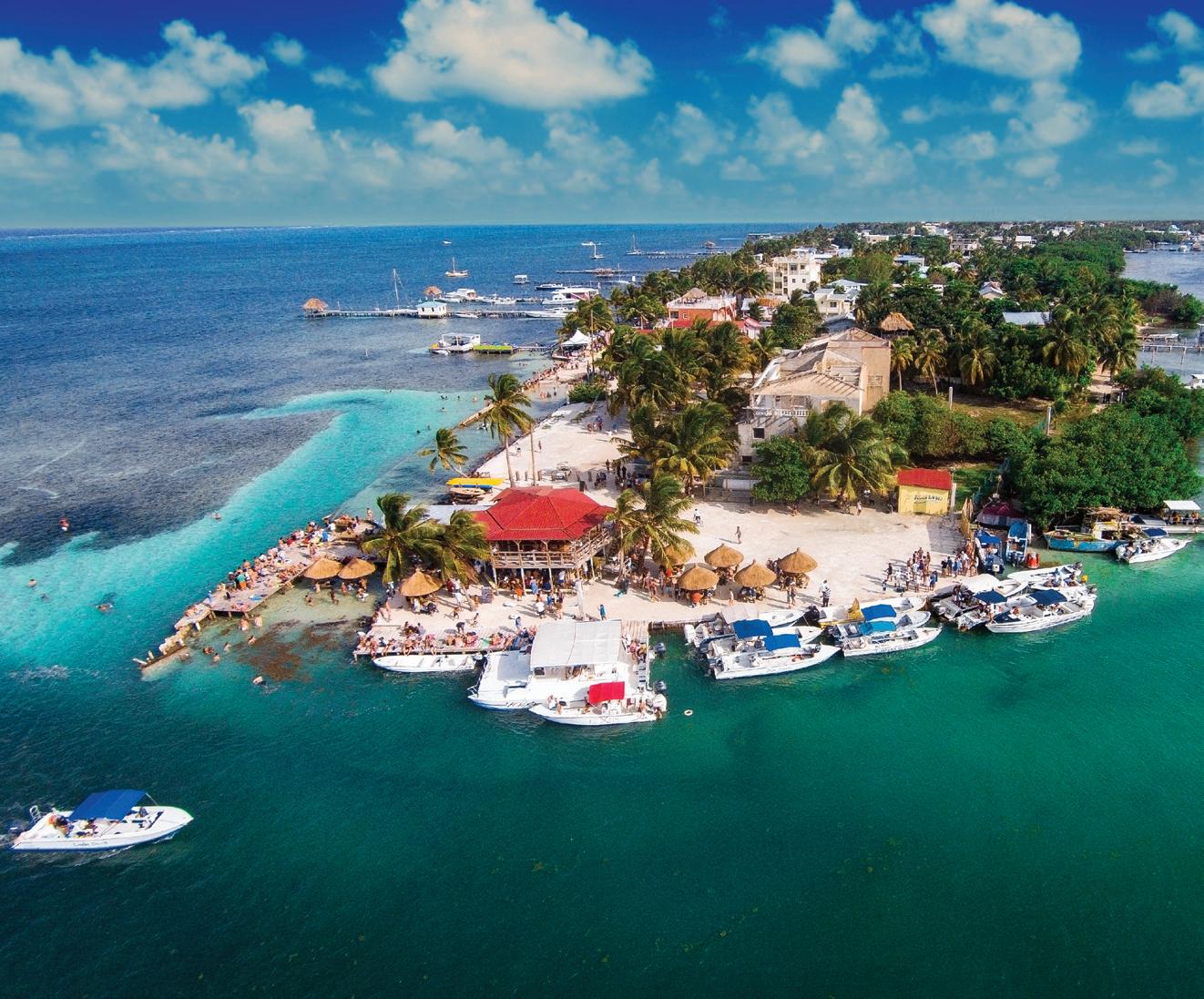
The intensity of the outcry threw a years-long campaign to ban offshore oil into overdrive, Chanona said. “I don’t think anyone was really prepared for the visceral reaction.”
A
bitter spill Sometime in the mid-2000s, unbeknownst to most citizens, Belize’s Geology and Petroleum Department had published maps revealing that the entire country, marine monuments and the famous Blue Hole included, had been carved up into oil concessions. The maps remained niche knowledge for researchers and oil companies until 2010, when tragedy struck 1,200 kilometers (800 miles) to the north.
On April 20, BP’s Deepwater Horizon platform exploded, killing 11 people and unleashing 200 million gallons of toxic oil into the Gulf of Mexico. Billions of dollars were lost as fishing withered and tourists vacationed elsewhere. “Everybody really realized: I had no idea it could be this bad, and this scary,” Chanona said. “That’s when a national consciousness about the inherent dangers of offshore oil kicked in.”
Oceana’s Belize office, then only a year old, had been campaigning to boot bottom trawling and other forms of destructive fishing off the country’s 300-kilometer (190-mile) barrier reef. The team realized that a toxic spill, slicking corals and poisoning wildlife, could render any marine conservation efforts moot. They publicized the Geology and Petroleum
12 | SPRING 2018 FEATURES
Caye Caulker is a popular tourist destination.
15,000 jobs in Belize are linked to seafood.
First lady Kim Simplis Barrow and her daughter Salima visit the Blue Hole.
Janelle Chanona, the head of Oceana in Belize, joins Minister of Tourism Manuel Heredia to discuss seismic blasting with residents of Ambergris Caye.


FEATURES
Belizeans gather to support a healthy, oil-free reef.

14 | SPRING 2018 FEATURES
Snappers, like this one snagged by a spearfisher, are commercially important residents of Belize’s reef.

FEATURES
Department maps, along with the fact that the government was actively courting offshore oil interests.
For many Belizeans, these were grim revelations. A giant spill would cripple the country’s economy. Thirty-five percent of all jobs in Belize depend on tourism, much of it centered on sport fishing, scuba diving and other activities that rely on a healthy ocean. Another 15,000 are tied to the seafood sector — huge numbers in a country of just 400,000 people.
Even ignoring the risks of a spill, Belizeans would see few benefits from drilling, explained Imani Fairweather-Morrison, a Belizean Oak Foundation program manager who supported Oceana’s anti-oil efforts. “It was appalling to everyone,” she said.
And the damages from drilling would go deeper than money. The barrier reef is a pillar of national pride, Chanona and FairweatherMorrison agreed. A string of seven UNESCO World Heritage sites along the reef host blue-footed boobies, whale sharks and vibrant coral atolls.
“As small as we are, we can lay claim to this amazing resource,” Chanona said. “The reef is an untarnished source of pride. We are a developing nation with so many challenges, and so many issues. But we have our reef.”
Something in the water
Following a victory that banned bottom trawling in Belize, stopping offshore oil became Oceana’s number one priority. The team flew Elsa Paz, then the mayor of San Pedro — an island town on Ambergris Caye, Belize’s main tourist hub — to the Gulf of Mexico, where she saw and smelled the spill in person. The mayor carried her disgust back home, transforming San Pedro into a bulwark against offshore oil.

In 2011, the team cofounded the Belize Coalition to Save Our National Heritage, which eventually grew to almost 40 local and international partners. At first, the coalition focused on drumming
up grassroots support for a ban among fishermen and tourism operators, two groups with the highest stakes in a healthy ocean.

Soon, however, it became clear that the coalition’s community presentations and print, TV and radio ads were reaching a bigger audience. It “was awesome that we were getting more support from laymen” than expected, said Amanda Burgos-Acosta, the director of the Belize Audubon Society, a coalition member.
In 2012, the coalition harnessed public sentiment to force a national referendum on offshore oil. Fifteen-thousand signatures are required to trigger a referendum vote. Oceana and its allies collected 20,000. But the disqualification of 8,000 signatures eliminated the possibility of an official referendum. Undeterred, the coalition launched the “People’s Referendum,” staffing 51 polling stations across the country.
Burgos-Acosta recalled a conversation with a voter who arrived carrying his baby daughter. “I’m here to put my vote and my voice to this,” he told her, “because I want my baby to enjoy the sea the way I do.” She added: “To him, it was a personal connection.”
Almost 30,000 people voted, a turnout Burgos-Acosta called “phenomenal.” Ninety-six percent of votes cast were in favor of a permanent ban on offshore oil. But this flood of public support failed to persuade the government. For the next three years, little changed.
The coalition kept the pressure on. Fairweather-Morrison, of the Oak Foundation, praised Chanona’s tenacity. “She never let up. She would always knock, always call, always keep the lines of communication open,” she said. “It’s extraordinary really — the understanding that you hold more with an open hand than a clenched fist.”
Seismic upset
In December 2015, hope flickered into focus. The government announced that it would permanently ban offshore oil exploration along the barrier reef and within World Heritage sites. But the new
FEATURES 16 | SPRING 2018
Nurse sharks and horse-eye jacks cruise along a seagrass bed.
Small-scale fishing accounts for 3 percent of Belize’s GDP.
protections only covered 15 percent of Belize’s marine territory. It was a step in the right direction, Oceana and other coalition members said, but it wasn’t enough.
Then, on October 12, 2016, Oceana received an alarming phone tip: The government had approved a contract for oil exploration a kilometer off the reef, despite its public promises.
Days later, the Oceana team accessed satellite tracking data and discovered that a seismic ship, the Northern Explorer, had already entered Belizean waters. Oceana and the coalition called on the government to postpone airgun blasting until the public had a chance to weigh in.
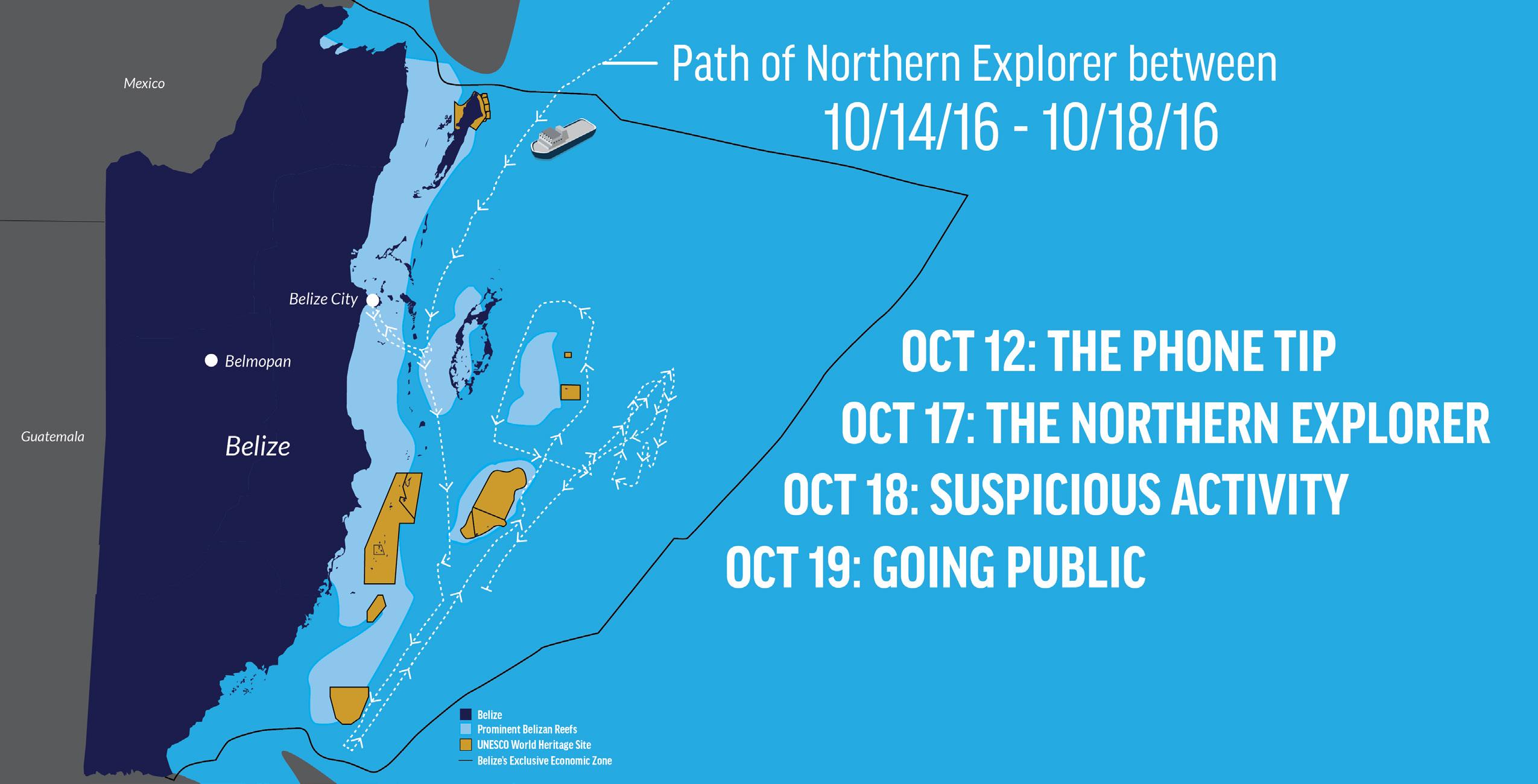
But on October 18, satellite maps showed the ship tracing a back-and-forth pattern near Turneffe Atoll — movements characteristic of seismic airgun use. The team’s suspicions were confirmed when a San Pedro resident aboard a light plane snapped photos of the vessel towing bubbling airguns, the same ones that divemaster Jamani Balderamos heard as thunder.
The next day, Oceana and its allies went live with this evidence. Tourism-dependent San Pedro erupted with anger. Guides and business owners debated shutting down the country’s tourism industry in protest. Locals packed a raucous meeting with government officials at a San Pedro hotel, demanding answers that were in short supply.
“We as NGOs didn’t even have to say anything, because the people were so vocal about what they wanted. And the biggest thing they wanted was the boat out of Belizean waters,” Burgos-Acosta said. “I think at that point, the game kind of changed.”
Minister of Tourism Manuel Heredia, who also serves as a local representative for San Pedro and surrounding areas, was among the crowd at the meeting. Afterwards, he spoke with Prime Minister Dean Barrow, who ordered the seismic ship out of the country the next day.
Coalition members noted the significance of the anti-seismic outcry. “The public’s insistence to be meaningfully consulted on this issue has and will never waver,” Chanona said. “That was what made the difference.”
In August 2017, following consultations with Oceana and the Belize Coalition, Prime Minister Dean Barrow announced his government’s plans to institute an indefinite moratorium on offshore oil exploration and drilling in the country’s marine territory.
The bill was introduced on December 9, and received bipartisan support in Belize’s House of Representatives and unanimous endorsement in the senate. On December 30, the moratorium became law, making Belize the world’s first country to reject all offshore oil.
Fairweather-Morrison praised the decision. “When you see places like Belize standing up, making this sort of choice about its path for development,” she said, “it’s really heart-warming and encouraging.”
There are still big battles ahead for Belize’s reef. Overfishing, irresponsible coastal development and climate change are major concerns. “But for now, stopping offshore oil has put Belize in the international headlines for the right reason,” said Chanona. “Now the world knows that if the oil lobby ever comes knocking again, it will be answered by a healthy dose of Belizean pride.”
FEATURES OCEANA.ORG | 17
IN THE PHILIPPINES, THE QUEST TO GLIMPSE A TINY GIANT

FEATURES 18 | SPRING 2018
Spinner dolphins, the most acrobatic residents of Tañon Strait, can spin five times in a single jump.
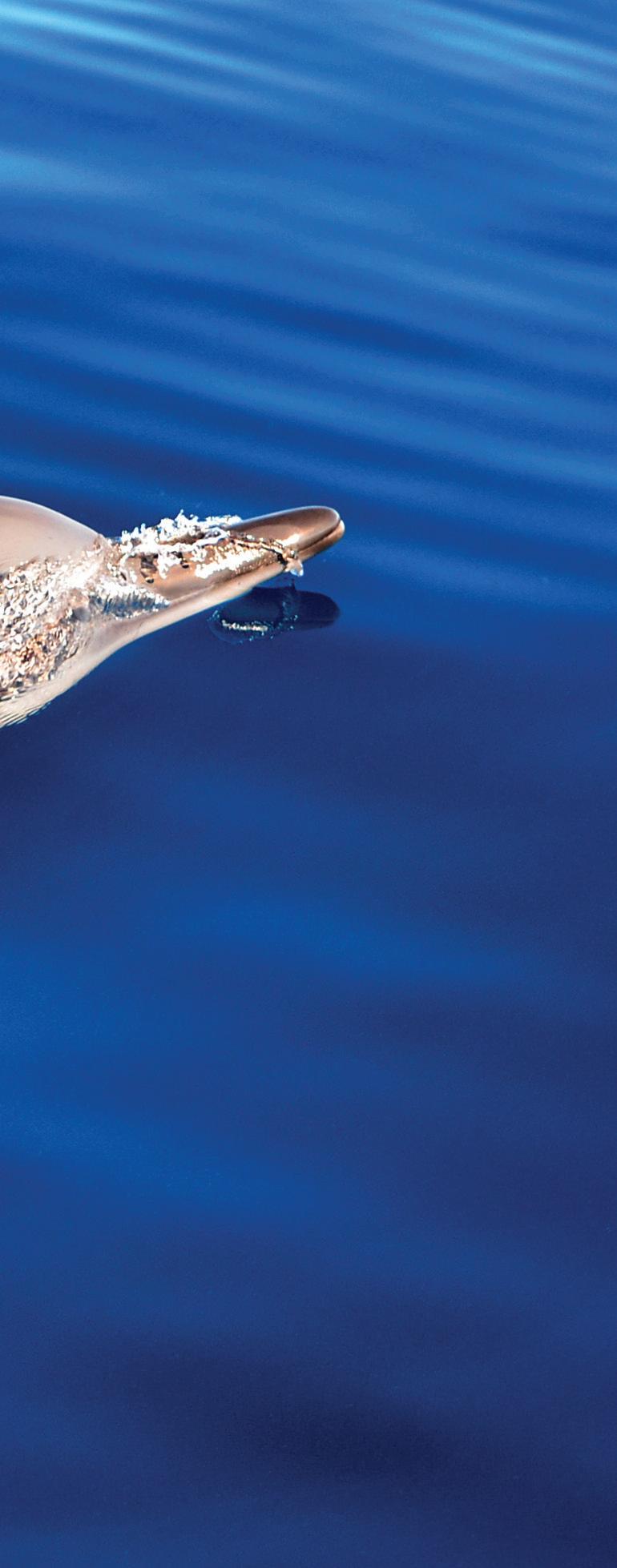
Likea sports team before a big game, we clasped our hands and bowed our heads in prayer — except we were in the middle of Tañon Strait, surrounded by sweaty boatmen.
Captain Ricardo Reynaldo finished his prayer and gestured to the water, strangely calm that morning. Bottlenose, spinner and Risso’s dolphins are common here, he said. Our quarry, the pygmy sperm whale, is elusive.
These shy, 3.5-meter relatives of the giant sperm whale don’t leap or spout, so it’s almost impossible to spot them save in the calmest of seas. In fact, our captain hasn’t seen one in three months. “But perhaps,” he says with a smile, “someone down there heard our prayers.”
Pod squad Aboard the M/Bca Ezrha, our sea-squad had sailed from the quaint coastal town of Bais to the center of Tañon Strait, one of the biggest protected seascapes in the Philippines.
Thirty minutes after our prayer, our crew was swapping tales and eating breakfast on the boat, eyes occasionally scanning the horizon for our quarry. Suddenly, the grizzled captain pointed to a seemingly empty patch of sea, abuzz with red-necked phalaropes. “There! Look at the birds!”
A league off, the blue water began to churn under the circling phalaropes. Our boat approached the roiling, bubbling mass. Seabirds squawked overhead. “It
is a bait-ball,” a boatman explained — a giant school of small fish driven up from the depths. By its fringes I noted dark, triangular dorsal fins. Dolphins. And dozens of them!
Suddenly, they started jumping. The passengers clapped and cheered. I grinned as I caught myself clapping along with everyone else. I’ve been watching dolphins for years, and it’s like this every time.
A porpoise-full place Tañon Strait, a 161-kilometer (100-mile) channel dividing the islands of Cebu and Negros, is home to 14 species of whales and dolphins, most of which can be seen off Bais. Their abundance is proof of a healthy ocean.
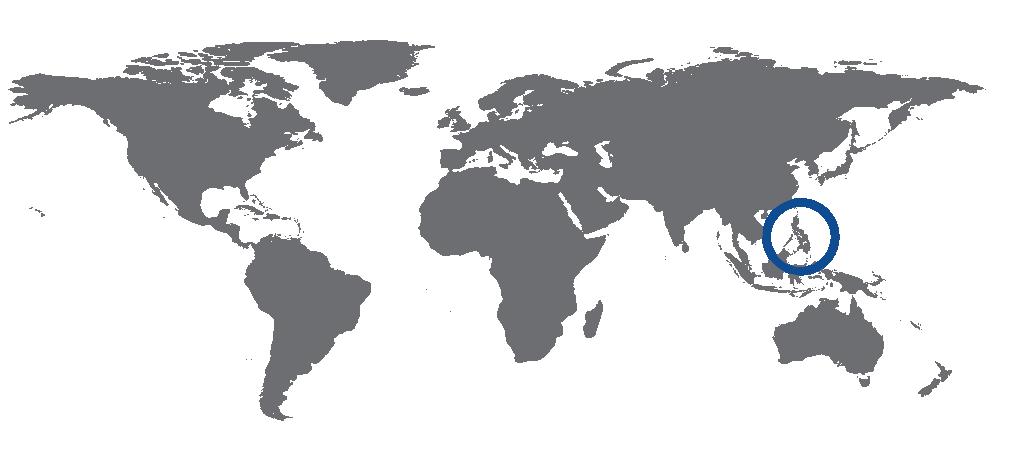
“Cetaceans are extremely important for the marine ecosystem,” said AA Yaptinchay, the director of the conservation nonprofit Marine Wildlife Watch of the Philippines. “Most are apex or top-level predators which regulate populations of fish and squid — thereby keeping the ecosystem balanced to promote diversity.” Huge whales also fertilize the ocean with their poop, he added, which encourages plankton growth.
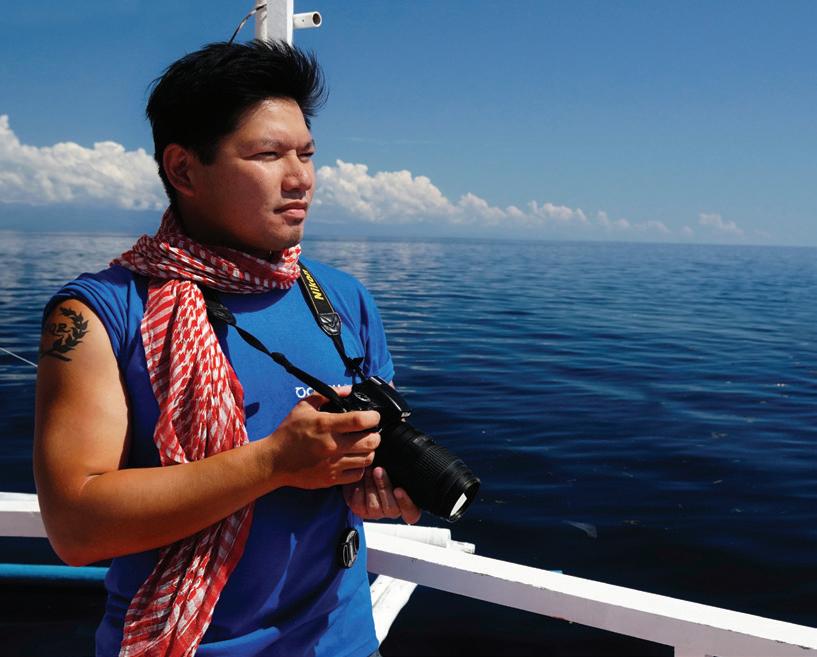
Once hunted for their meat and blubber, all cetaceans are now protected in the Philippines. Still, many drown after accidental entanglement in fishing gear. Globally, over 300,000 whales, dolphins and porpoises die this way every year. Other threats include marine debris and
Written by Gregg Yan Photographs by Gregg Yan unless noted otherwise
OCEANA.ORG | 19 FEATURES
Gregg Yan searches for a little-seen resident of one of the country’s largest marine protected areas

FEATURES
Whales and dolphins were once hunted in Tañon Strait. Now, they support thriving ecotourism businesses based in Bais City, on the southwestern end of this protected seascape.

FEATURES
plastic pollution, habitat destruction, overfishing and hunting in remote parts of the country.
Tañon Strait’s thriving whales and dolphins draw tourists, bringing income to coastal communities. “Charismatic creatures like dolphins bring in millions of pesos from ecotourism, enriching the lives of the people of Bais and other coastal areas,” said Gloria Estenzo-Ramos, head of Oceana in the Philippines. “When done right, tourism is solid proof that many animals are worth more alive than dead.”
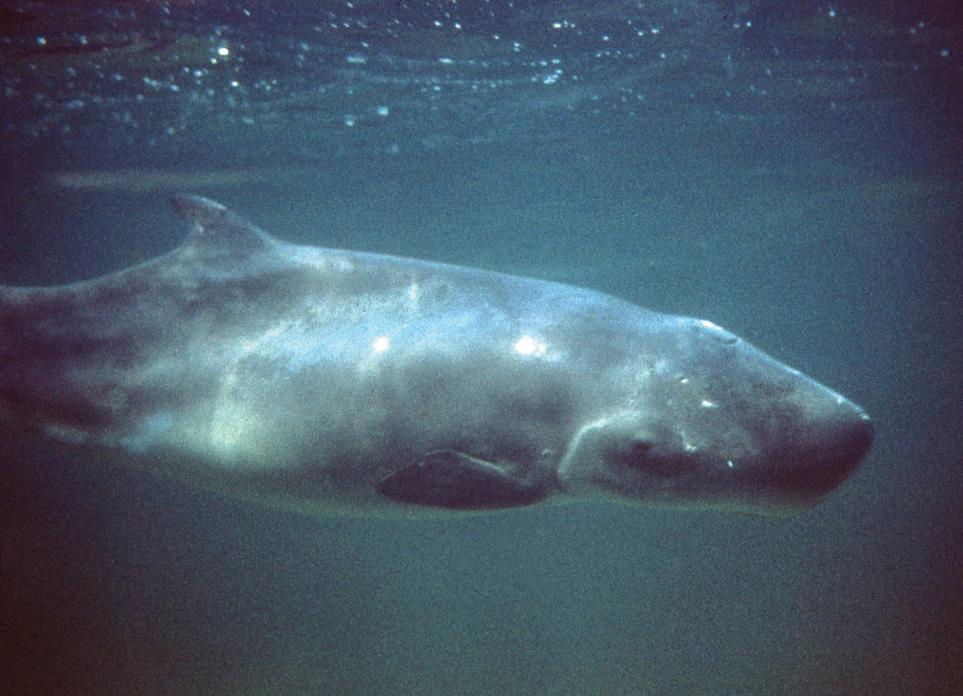
Right now, Oceana is fighting for the future of Tañon’s marine mammals. The team is protecting vital habitats, and working with local allies to ensure there’s enough fish to feed both wildlife and local fishing communities. Recently, Oceana, other nonprofits and the Philippine government began pilottesting a vessel monitoring system to combat rampant illegal commercial fishing in the Strait.
Special treats

From the boat, we observe Tañon Strait’s stars in action. They’re spinner dolphins, distinguished by their elongated snouts and acrobatic leaps, somersaults and corkscrews.
After a few frenzied minutes, Captain Reynaldo shouts the three words we’ve been waiting for all morning: “Pygmy sperm whales!”
Drawn to the commotion, a pair of the whales have come to feast on the bait ball. We don’t approach, staying the prescribed 100 meters away. I snap shots as fast as I can, but they’re too far out. I exhale and reluctantly lower my camera. After a magical minute, they’re gone.
Soon more boats arrive and we head back to Bais to let other visitors enjoy the morning. Captain Reynaldo unleashes the coup-de-grace: cold drinks and frozen watermelons. We laugh and dive in. As the dolphins and whales have their breakfast, so do we.
22 | SPRING 2018
Red-necked phalaropes search for fish.
Pygmy sperm whales are elusive residents of tropical and temperate seas.
FEATURES
©David Caldwell
Tañon Strait is a migration highway for whale sharks, the world’s largest non-mammal vertebrate.

 Sardines, a favorite food of pygmy sperm whales, swarm above a Tañon reef.
©Oceana/Steve de Neef
©Oceana/Steve De Neef
Sardines, a favorite food of pygmy sperm whales, swarm above a Tañon reef.
©Oceana/Steve de Neef
©Oceana/Steve De Neef
Proof that marine reserves help fishermen
Back in 2000, a team of researchers headed by marine biologist Callum Roberts headed to St. Lucia, an island nation in the Caribbean, to check up on a five-year-old marine reserve where fishing had been banned.
Inside the bounds of the Soufriere Marine Management Area, commercial fish had staged a miraculous recovery, with average abundance leaping five-fold. But perhaps the more astonishing result was what had happened outside. Despite losing a third of their fishing grounds, fishermen were catching between 50 and 90 percent more fish per trip.
It was some of the earliest evidence for “spillover” theory. Spillover happens when a marine reserve becomes so saturated with fish that they “spill over” into adjacent fishing grounds. This effect isn’t limited just to adult fish. Eggs and larvae can also drift out of reserves and settle down in spots where they’ll grow and eventually get caught.
“We now know that marine reserves do more than just protect biodiversity inside their borders,” said Kathryn Matthews, Oceana’s deputy chief scientist. “Protection of spawning grounds, nurseries and sensitive reef habitats are critical to ensuring the abundance of species which rely on these areas to mate, grow and seek refuge.”
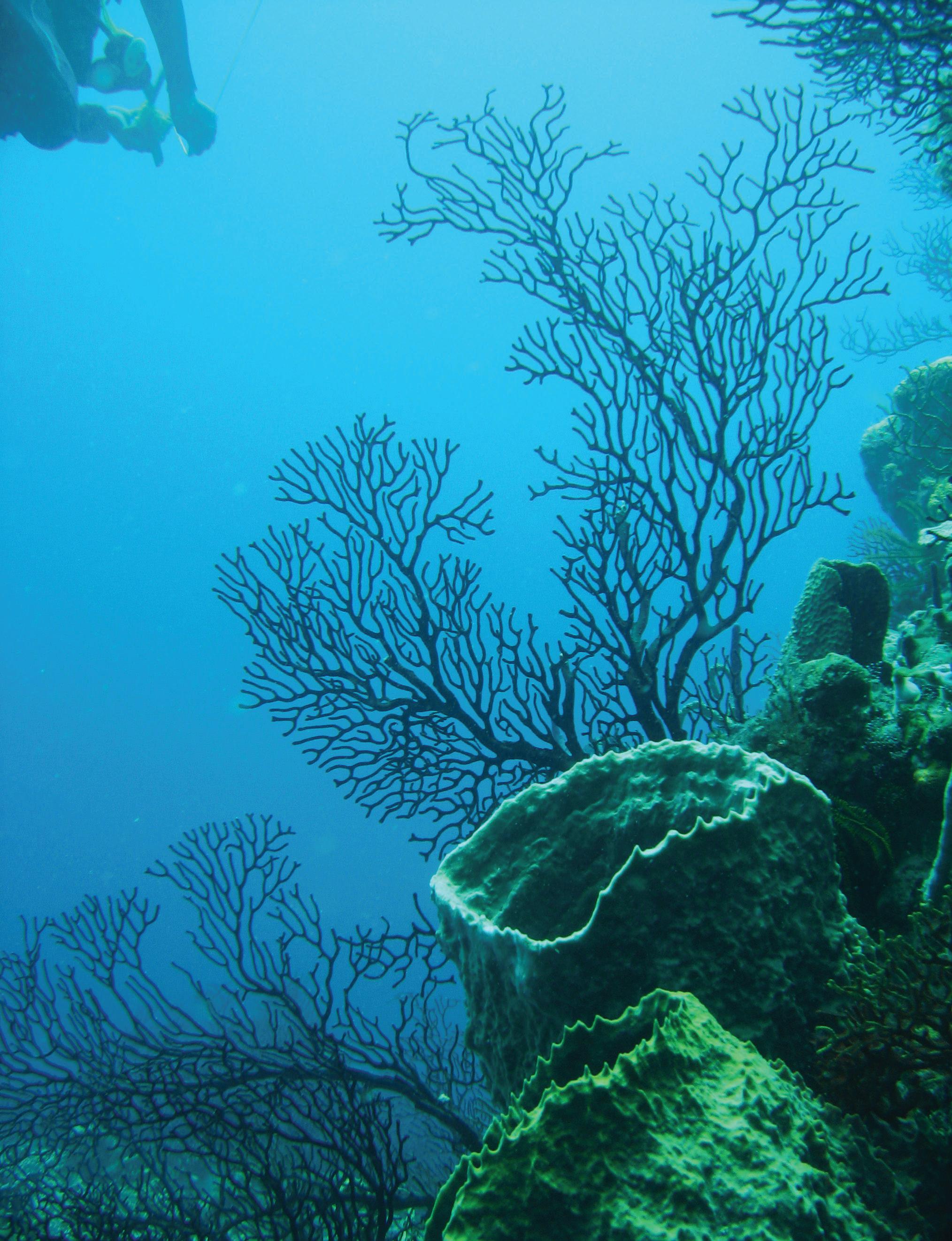
Since the early 2000s, scientists have found the spillover effect in reserves big and small. In South Africa, for example, fishermen caught dramatically more fish for less effort in the ten years following the creation of the 40-squarekilometer Goukamma Marine Protected Area. Booming scallop populations in several huge areas in New England’s Georges Bank have churned out loads of larvae, which hitch rides on ocean currents and seed scallop grounds outside the protected zones.
“This is one of the reasons why Oceana has helped create marine reserves around the world,” Matthews said. “When properly designed, and part of a science-based management plan, protected areas are a highly effective tool in a fishery manager’s toolkit.”
24 | SPRING 2018 FISH TALE
© WRI Staff
MEET THE SEACHANGE CO-CHAIRS
This year’s SeaChange Summer Party takes place on Saturday, July 21, with an intimate concert by acclaimed singer, songwriter and actress Katharine McPhee. Voted “Best Gala in Orange County,” the event takes place in Laguna Beach, California, at a stunning private estate with expansive views of the Pacific Ocean. The first decade of SeaChange annual parties has raised over $12 million for ocean conservation.



Oceana board vice chair Valarie Van Cleave, a longtime ocean advocate and avid scuba diver, is a founder and co-chair of the SeaChange Summer Party. She is committed to promoting responsible management of ocean resources and protecting marine wildlife and habitats.
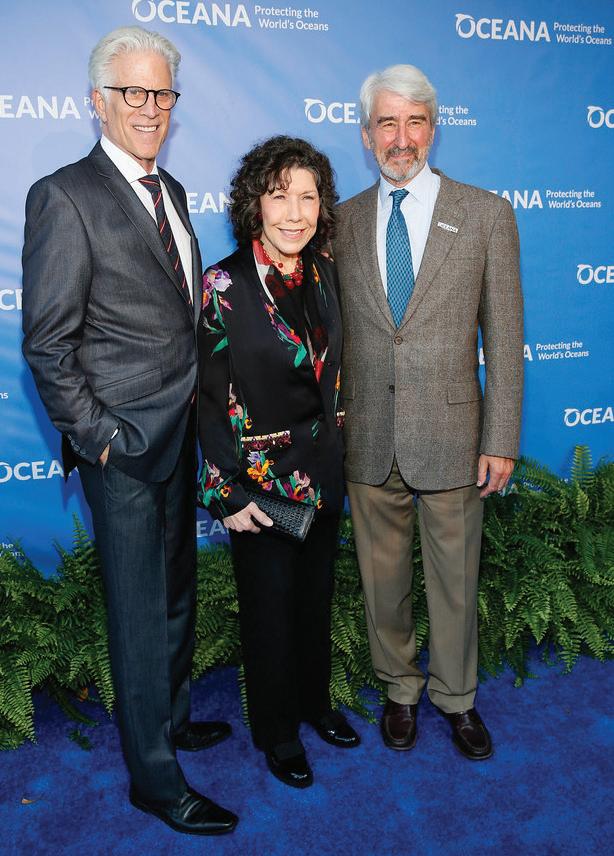
SeaChange co-chair Elizabeth Wahler is the founder and CEO of Kiére Media, Inc. Wahler’s interest in restoring ocean abundance has been directly influenced by her father’s visionary environmental work in air pollution control, and by growing up in southern California with the ocean in her backyard.
Van Cleave and Wahler are grateful for the past generous support of SeaChange from Orange County. Together with Jeff Blasingame, the 2018 SeaChange vice chair, they look forward to this year’s event.

EVENTS
OCEANA.ORG | 25
Elizabeth Wahler (left) and Valarie Van Cleave (right)
Past SeaChange Special Guests, from left to right: Seth MacFarlane; Leonardo DiCaprio; Ted Danson, Lily Tomlin and Sam Waterston (Photographs: ©Ryan Miller)
Singer, songwriter and actress Katherine McPhee.
©Alex Berliner
SUBSIDIZING DISASTER
The world’s fishing fleet is too big, and fish stocks are dwindling. Many fleets are even losing money. Yet fishing continues, fueled by government subsidies that pay fishers to stay at sea, even when they catch too little to turn a profit.
Dr. Daniel Pauly spoke with his long-time colleague at the University of British Colombia, Dr. Rashid Sumaila, to discuss why perverse subsidies exist and what can be done to fix them. Sumaila, a leading fisheries economist, recently joined Pauly as a member of Oceana’s board of directors.
OCEANA: Why do subsidies exist in the first place?
PAULY: Fisheries subsidies have a different origin than agricultural subsidies. In France and in England, fisheries have been traditionally subsidized, beginning as early as three centuries ago, because these two countries wanted to maintain a number of operational fishers that could crew warships. These subsidies were part of the defense budget.
RASHID SUMAILA: Subsidies made sense when most of the world’s fish stocks were underexploited. In the 1950s and 1960s, the more subsidies a government gave, the more catch it got back. For many countries, that’s not the case anymore.
OCEANA: How do subsidies spur overfishing?
SUMAILA: In theory, fisheries should be self-regulating. When fish stocks get too low, or fishing gets too expensive, workers and investments should move out of the fishery. But

26 | SPRING 2018
ASK DR. PAULY
in practice, unprofitable fleets can continue fishing — and can even grow larger — when they receive government subsidies.
The problem is enormous. In a 2015 study, my group at the University of British Columbia estimated that global fishing subsidies in 2009 were $35 billion, between 30 and 40 percent of the total value earned by marine fisheries worldwide. As a result of this artificial profit-boosting, and general mismanagement, the global fishing fleet is about twice the size the ocean can sustainably support.
OCEANA: Why don’t countries get rid of harmful subsidies?
PAULY: The issue is that the first country to stop will be at a competitive disadvantage. The fish that they sell will become comparatively more expensive. And if other countries don’t follow up immediately, the first country will not be able to sell its seafood.
Some countries say they have gotten rid of subsidies, but figuring out whether this is true is tricky. We have discovered that Australia, one of the countries which claim to have gotten rid of subsidies, now gives them under different names.
OCEANA: Can fishing subsidies ever be beneficial?
SUMAILA: Subsidies can be divided into three broad categories. The first category, capacity enhancing subsidies, is what promotes overfishing. The second, ambiguous subsidies, can either promote positive or negative outcomes, depending on how they are implemented. And the third category, the beneficial category, supports research and management. If you have a good management system, for example, you can detect illegal fishers and catch them.
PAULY: I can think of a scenario where you have fishers landing fish on the beach, throwing the fish in the sand, and later smoking them using procedures that waste fuel wood. You get a very bad product all the way from the landing and processing to the sale. Subsidies applied here could improve the product quality post-harvest. Thus, subsidies could finance concrete tables to display the fish, and well-designed smoking chimneys that make efficient use of fuel. This would make a great difference in increasing incomes.
SUMAILA: The issue is that very few subsidies are of the beneficial sort. Nearly 60 percent of the global total goes to harmful subsidies like ship fuel. Instead of giving away subsidies that lead to overcapacity and overfishing, keep
the money in the community. Use that money to upgrade the catch, rather than destroy the resource by intensifying overfishing.
OCEANA: What can be done? SUMAILA: One of the things we could do practically is take the top-subsidizing countries — there are a maybe a dozen — and then create cadres in these countries of biologists, economists and other thought-leaders to help their government really see how bad this is, and push through action. Sometimes it’s better to tackle global issues on a global stage, but sometimes one person in one country does something, and then that becomes something global.
PAULY: The irony about subsidies is that they contradict the spirit of capitalism. We can get support for getting rid of them. And then you might get a breakthrough at the WTO. Whether it happens through the WTO, or through multilateral arrangement, it is possible that subsidies could at least decline.
OCEANA: Scientists, international bodies and organizations like Oceana have been raising the alarm about subsidies for decades. Has this helped?
SUMAILA: My own thinking is that these efforts have slowed the tendency to give subsidies. It would have been worse if these kinds of efforts were not in place. When it comes to subsidies, governments are looking over their shoulders now.
Dr. Daniel Pauly is the founder and director of the Sea Around Us project at the University of British Columbia’s Institute for the Oceans and Fisheries, and is a member of the Oceana board.
Dr. Rashid Sumaila is the director of the Fisheries Economics Research Unit at the University of British Columbia’s Institute for the Oceans and Fisheries, and is a member of the Oceana board.

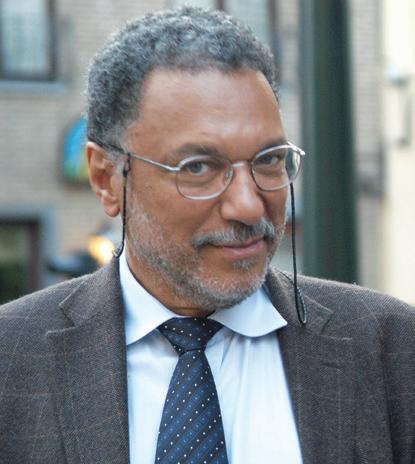
OCEANA.ORG | 27
ASK DR. PAULY
SUPPORTER SPOTLIGHT:


During his childhood summers on the coast of Maine, David Rockefeller, Jr., found more than young crabs and periwinkles at the ocean’s edge. He also discovered sailing, one of the driving passions of his life.
Over his 40 years as a sailor, Rockefeller has raced and cruised from Labrador to Miami, San Diego to Alaska, Scotland and Sweden to Turkey, and Italy. As many as 200 fellow sailors have joined the extensive sailing excursions he has personally organized in the United States and abroad.
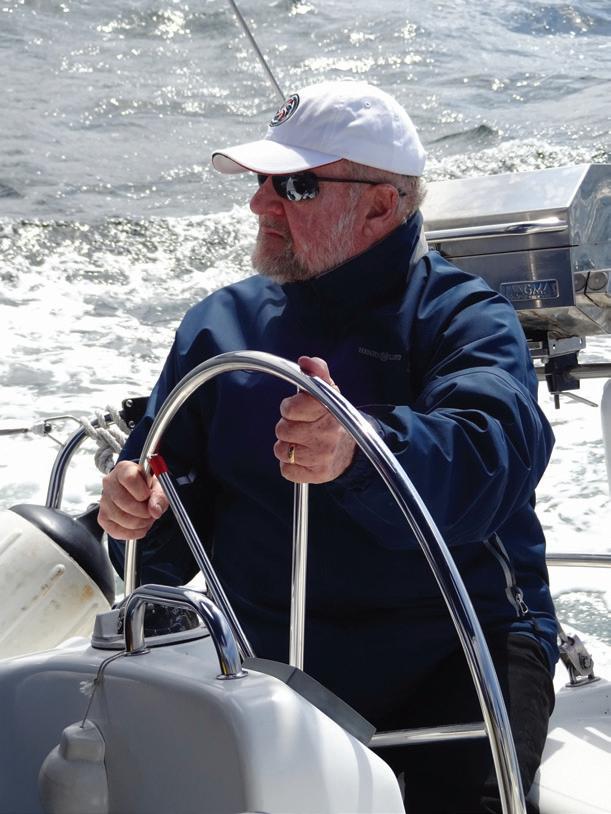
His sailing career has brought Rockefeller in direct contact with troubling changes in the sea: vanishing cod and flounder in New England, trash-filled harbors, winds shifting as the world heats up. But his course from sailing to conservation wasn’t necessarily a direct one. “It took years of being at sea — and especially on expeditions to other parts of the ocean — before I realized that there was trouble beneath the keel,” he said.
Rockefeller’s interest in marine conservation crystallized in 2000, when he joined the Pew Oceans Commission. As part of the commission, he spent nearly three years traveling around the United States and learning about the decline of fisheries and the harms of marine pollution. After helping to write the commission’s report, Rockefeller resolved to educate his fellow sailors about the challenges affecting the world’s oceans.
In 2004, he founded Sailors for the Sea in partnership with Dr. David Treadway to inform sailors about ocean-friendly boating, and to motivate action on marine conservation. Sailors for the Sea has since expanded beyond New England and other U.S. coastal states to affiliates in Japan and Portugal. The organization’s Clean Regattas program, the world’s only sustainability certification for water-based events, has reached over 400,000 sailors, from college athletes just getting started to the elites of the America’s Cup.

In 2017, Oceana reached out to Sailors for the Sea to explore the possibility of joining forces. Rockefeller was excited by the opportunities the partnership might offer. “Oceana had the science and scientists we did not, and we had access to a key ocean constituency, recreational boaters, which Oceana had not successfully reached,” he said.
The two entities’ boards of directors have unanimously approved the plan to join forces. The combination, which is subject to approval of Massachusetts courts, is expected to be finalized in the next year. In the meantime, Rockefeller has joined Oceana’s board of directors, and Sailors for the Sea board members have been invited to join Oceana’s Ocean Council.
“David has a long history as an ocean advocate, and we’re lucky that he’s joining our team,” said Oceana CEO Andy Sharpless. “With our newest allies aboard, we can continue winning victories for the oceans that provide sustenance, employment, inspiration and pleasure to people all over the world.”
For more information about Sailors for the Sea, please visit sailorsforthesea.org.
28 | SPRING 2018
DAVID ROCKEFELLER, JR. & SAILORS FOR THE SEA JOIN OCEANA SUPPORTER SPOTLIGHT
New York philanthropist David Rockefeller, Jr., recently joined Oceana’s board of directors. He brings with him decades of ocean advocacy experience, as well as Sailors for the Sea, the leading nonprofit dedicated to engaging ocean sailors in marine conservation.
David Rockefeller, Jr.
Sailors for the Sea staff (left to right) Shelley M. Brown, Ph. D. E., Amber Stronk and Robyn Albritton
Barton Seaver’s
Smoked sardines with mixed greens and fig-olive dressing
Serves two as a main course
This might be the most elegant salad ever come largely from a can. Sardines are the most economical seafood out there, plus you get great flavor and versatility. Try to find a greens mix that has a fair bit of arugula in it, as its peppery notes pair perfectly with the other flavors of this salad. The figs create a nice counterpart to the salty punch of the olives and the smoky rich sardines. If you cannot find fresh figs, dried ones are fine, but be sure to soak them in hot water for a few hours to soften them.

Ingredients Instructions
fresh figs, stemmed and quartered cup pitted green olives, chopped Juice of one lemon tablespoons extra-virgin olive oil Salt roasted red peppers, homemade or store-bought pound mixed greens (about 4 cups) Two, 4-ounce cans smoked skinless sardine fillets
1. For the dressing, toss figs, olives, lemon juice and olive oil in a small bowl. Season generously with salt and toss to combine.
2. Cut the peppers into strips and divide them between two serving plates. Divide the greens between the plates as well. Drain the sardines and separate the fillets. Place them on top of the salads, then spoon over the vinaigrette. Serve immediately.
This recipe originally appeared in For Cod and Country: Simple, Delicious, Sustainable Cooking. Photographs courtesy of Barton Seaver.

More than 80 percent of the seafood that Americans eat is imported — but it doesn’t have to be that way. Chef, writer and sustainability advocate Barton Seaver is on the vanguard of a movement that’s reacquainting Americans with their country’s maritime bounty. His latest book, American Seafood: Heritage, Culture & Cookery from Sea to Shining Sea, is a guide to more than 500 species and a riveting history of one of the United States’ most iconic industries.

2 2 1/4 2
6 1/4
CHEF’S CORNER OCEANA.ORG | 29
A riot of anemones offers shelter for a northern cod in Canada’s Gulf of St. Lawrence. Twenty-five years after the region’s devastating cod collapse, these iconic fish are showing signs of a fragile recovery.
This snapshot of deep-sea living was captured during a 2017 scientific expedition off Nova Scotia and Quebec. The expedition, a joint effort between Oceana Canada and Fisheries and Oceans Canada, explored sensitive seafloor habitats to better understand how to protect them.

PARTING SHOT
30 | SPRING 2018
©Canadian Scientific Submersible Facility/ROPOS, Oceana Canada and Fisheries and Oceans Canada
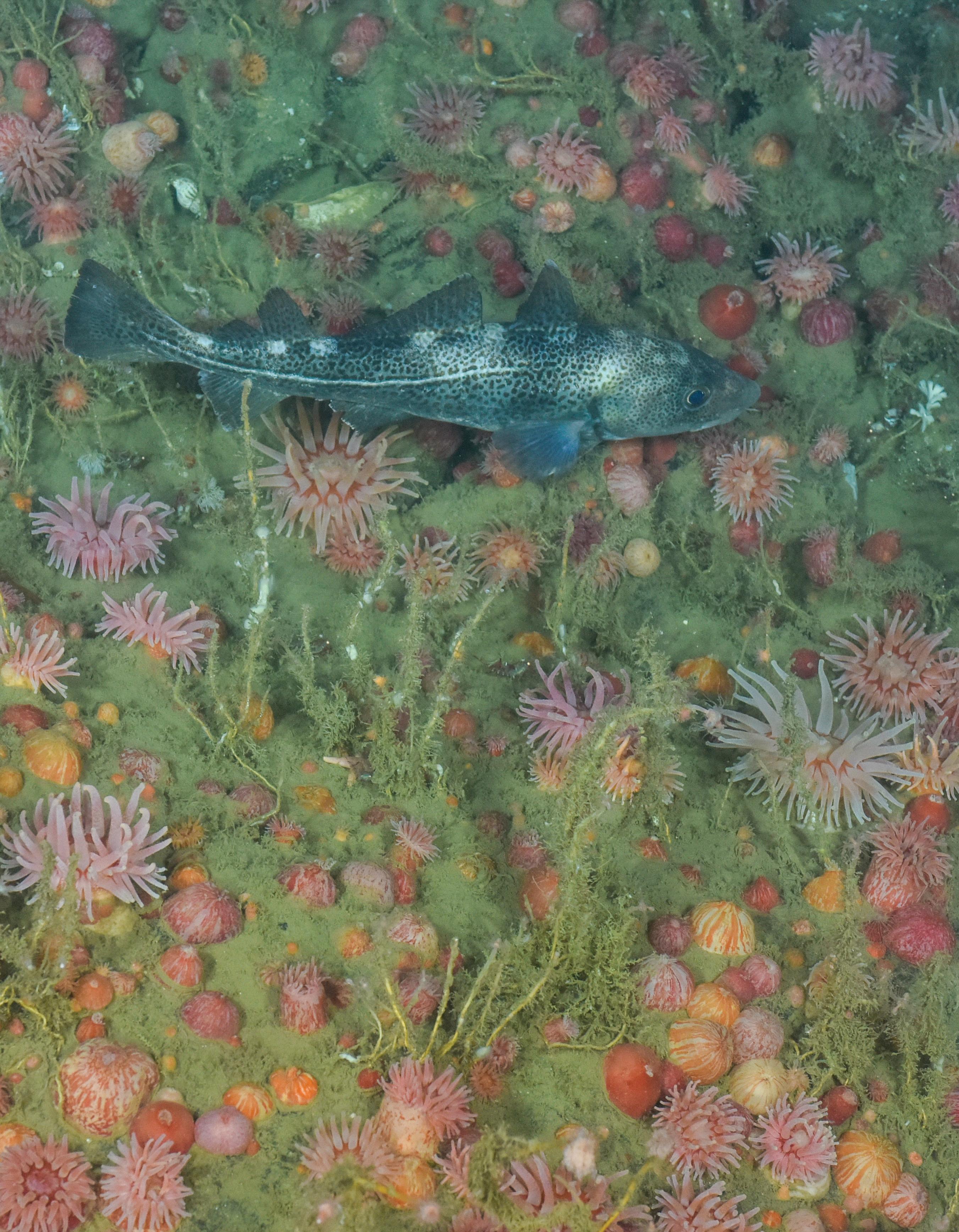
PARTING SHOT OCEANA.ORG | 31
1350 Connecticut Ave. NW, 5th Floor Washington, D.C. 20036 USA phone: +1.202.833.3900 toll-free: 1.877.7.OCEANA
Go to Oceana.org and give today.
Oceana’s accomplishments wouldn’t be possible without the support of its members.
Close-up
You can help Oceana fight to restore our oceans with your financial contribution. Call us today at 1.877.7.OCEANA, go to our website www.oceana.org/give and click on “give today” or use the envelope provided in this newsletter. You can also invest in the future of our oceans by remembering Oceana in your will. Please contact us to find out how. All contributions to Oceana are tax deductible. Oceana is a 501(c)(3) organization as designated by the Internal Revenue Service.
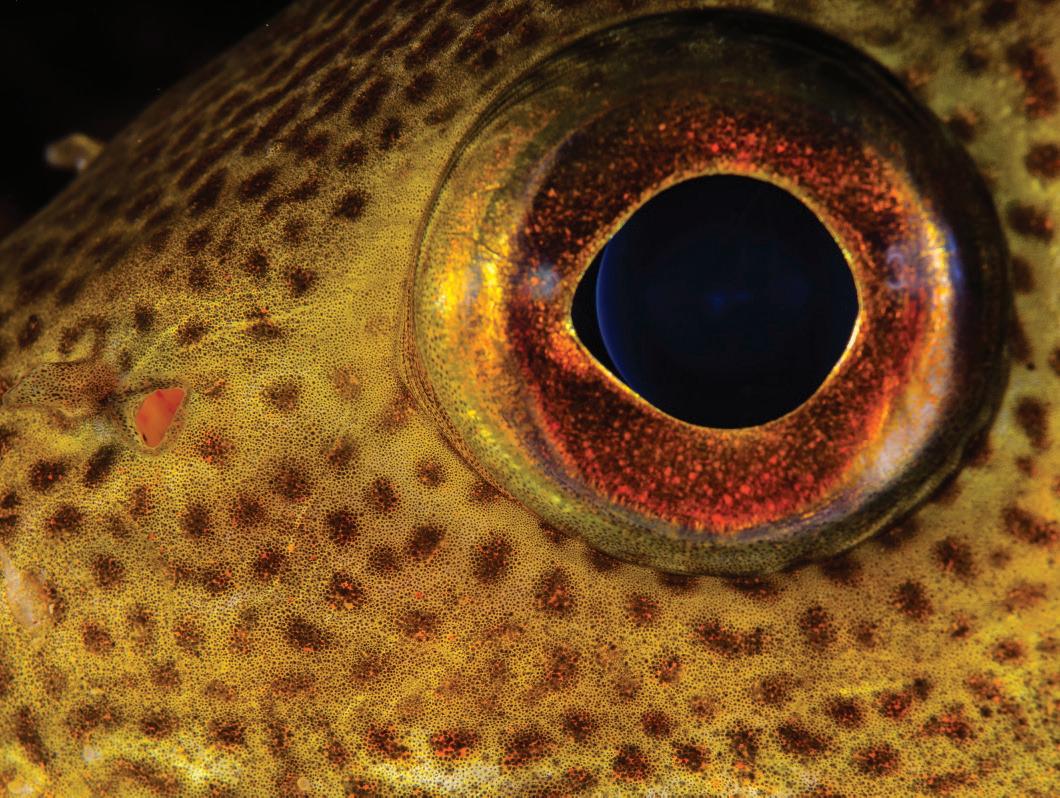 Global | Washington, D.C. Europe | Brussels | Copenhagen | Madrid North America | Boston | Ft. Lauderdale | Juneau | Mexico City | Monterey | New York | Portland | Toronto Central America | Belmopan South America | Brasilia | Santiago | Lima Asia | Manila
©Oceana/Juan Cuetos
of a cod’s eye off Thyborøn, Denmark.
Global | Washington, D.C. Europe | Brussels | Copenhagen | Madrid North America | Boston | Ft. Lauderdale | Juneau | Mexico City | Monterey | New York | Portland | Toronto Central America | Belmopan South America | Brasilia | Santiago | Lima Asia | Manila
©Oceana/Juan Cuetos
of a cod’s eye off Thyborøn, Denmark.
 WINTER 2017 | OCEANA.ORG
WINTER 2017 | OCEANA.ORG






























































 Sardines, a favorite food of pygmy sperm whales, swarm above a Tañon reef.
©Oceana/Steve de Neef
©Oceana/Steve De Neef
Sardines, a favorite food of pygmy sperm whales, swarm above a Tañon reef.
©Oceana/Steve de Neef
©Oceana/Steve De Neef


















 Global | Washington, D.C. Europe | Brussels | Copenhagen | Madrid North America | Boston | Ft. Lauderdale | Juneau | Mexico City | Monterey | New York | Portland | Toronto Central America | Belmopan South America | Brasilia | Santiago | Lima Asia | Manila
©Oceana/Juan Cuetos
of a cod’s eye off Thyborøn, Denmark.
Global | Washington, D.C. Europe | Brussels | Copenhagen | Madrid North America | Boston | Ft. Lauderdale | Juneau | Mexico City | Monterey | New York | Portland | Toronto Central America | Belmopan South America | Brasilia | Santiago | Lima Asia | Manila
©Oceana/Juan Cuetos
of a cod’s eye off Thyborøn, Denmark.